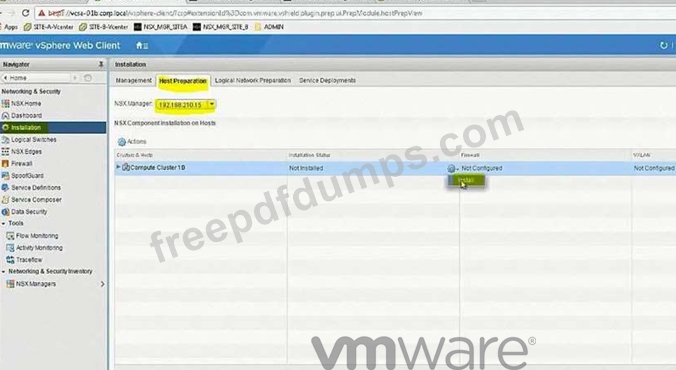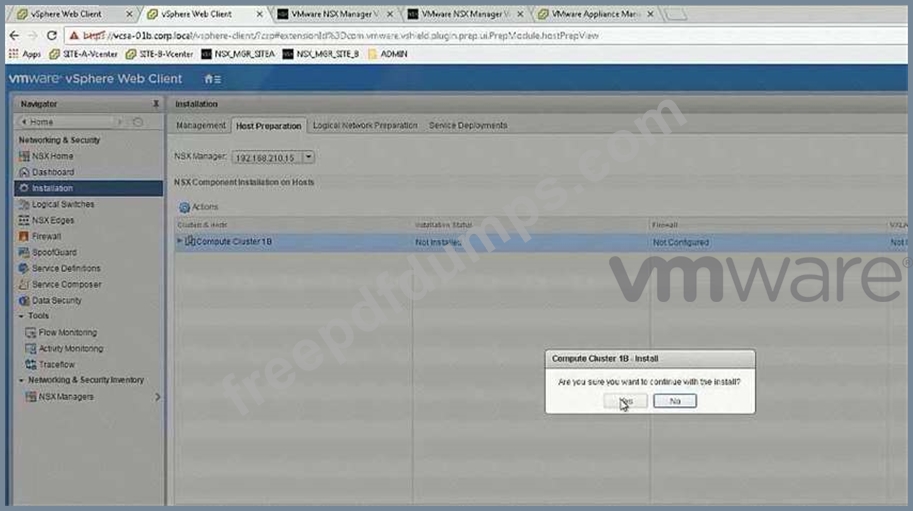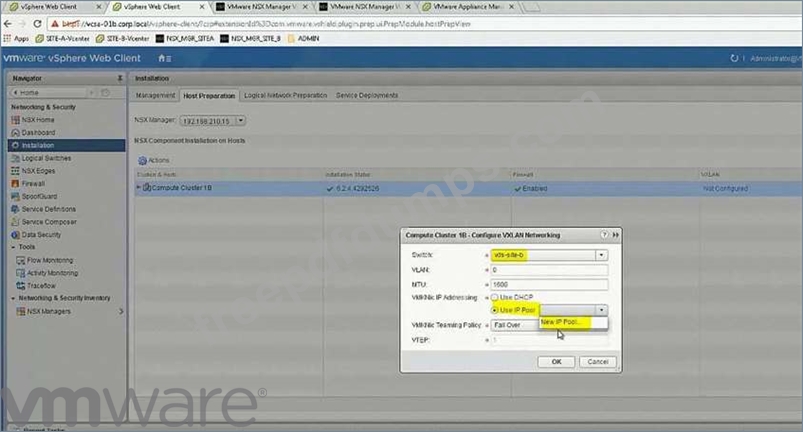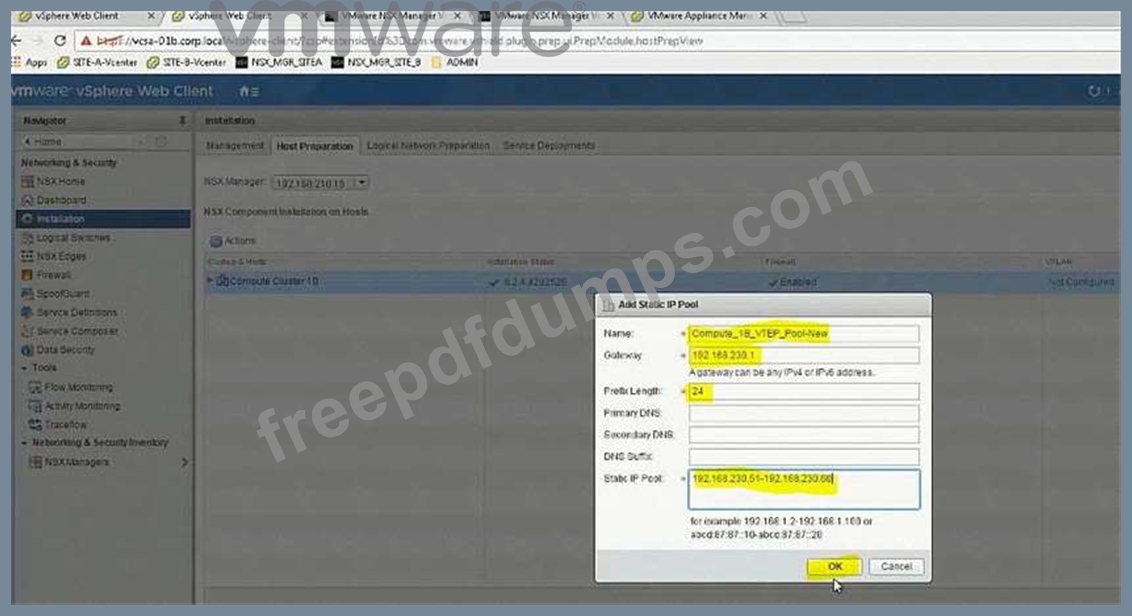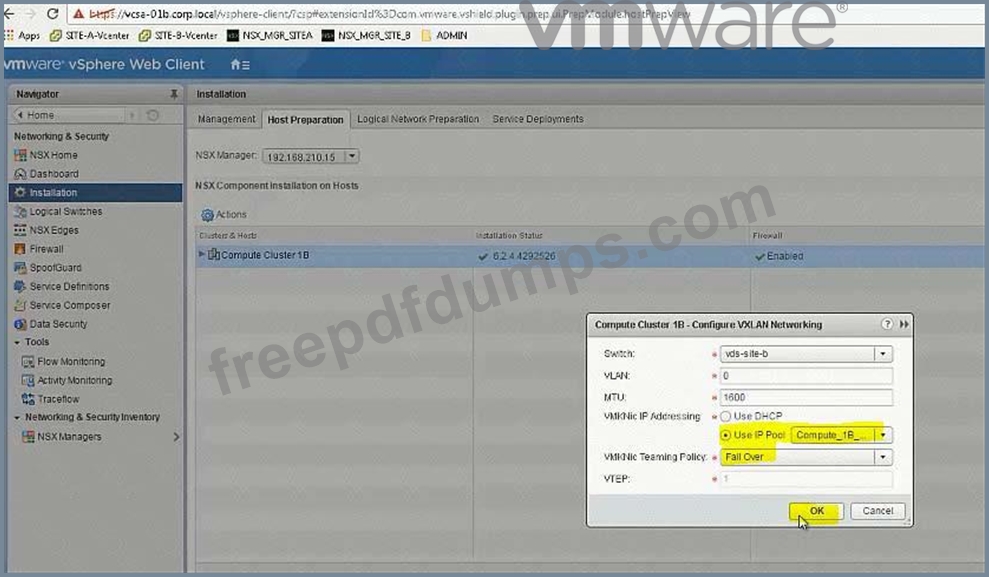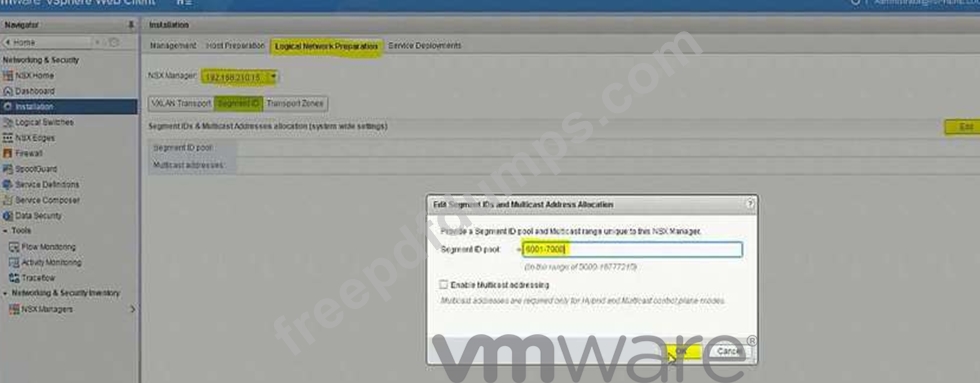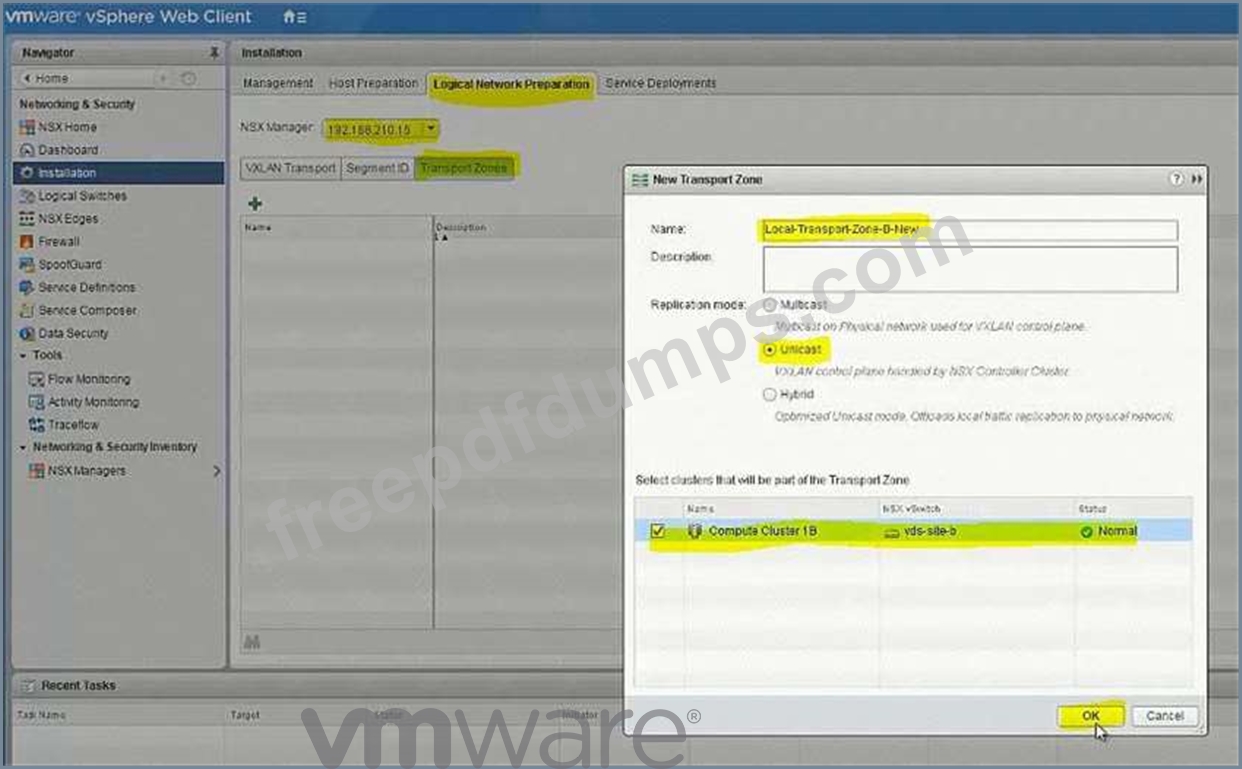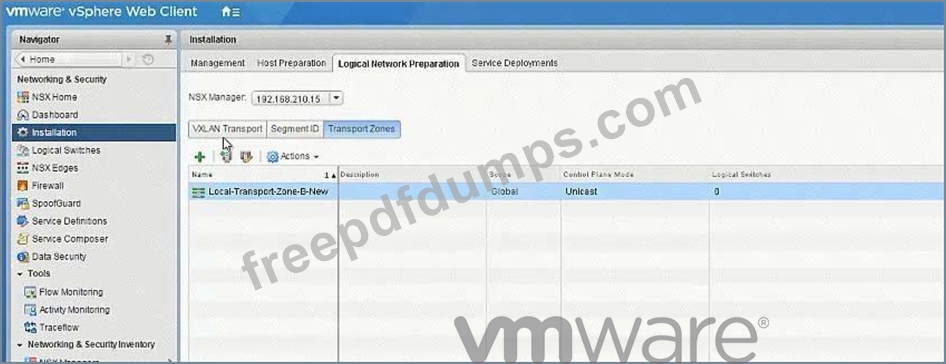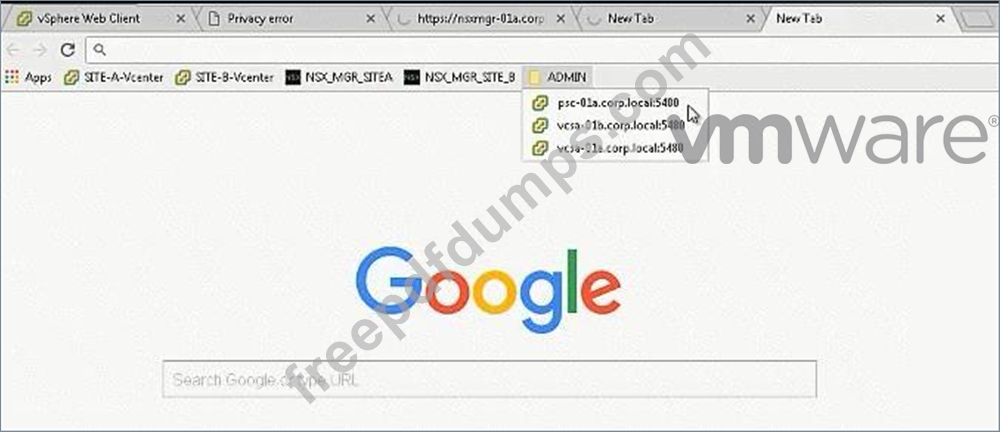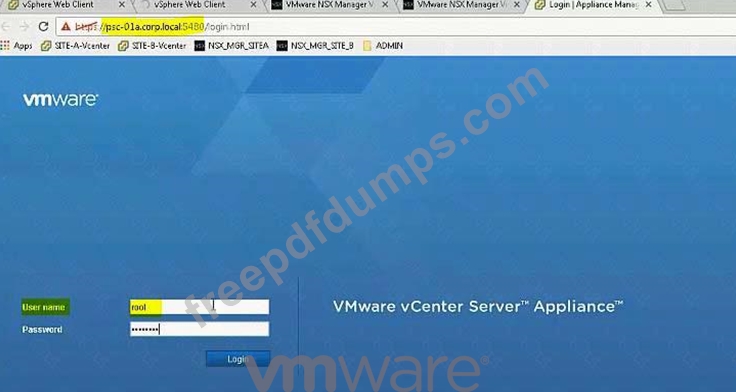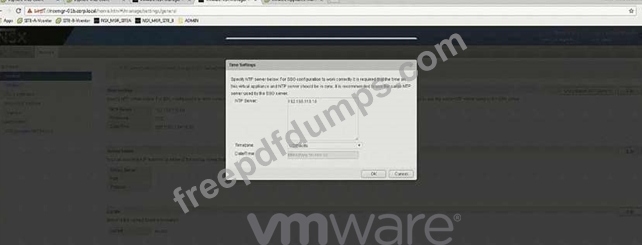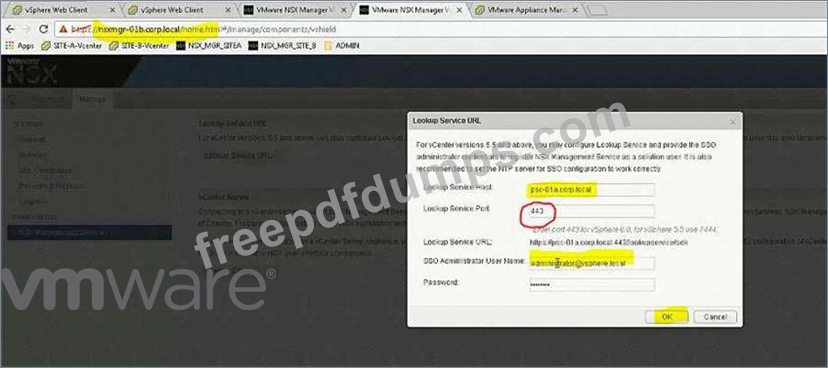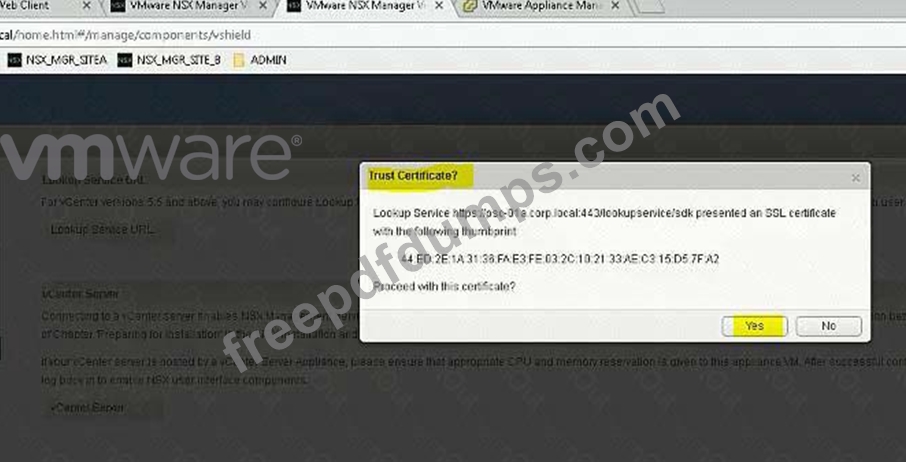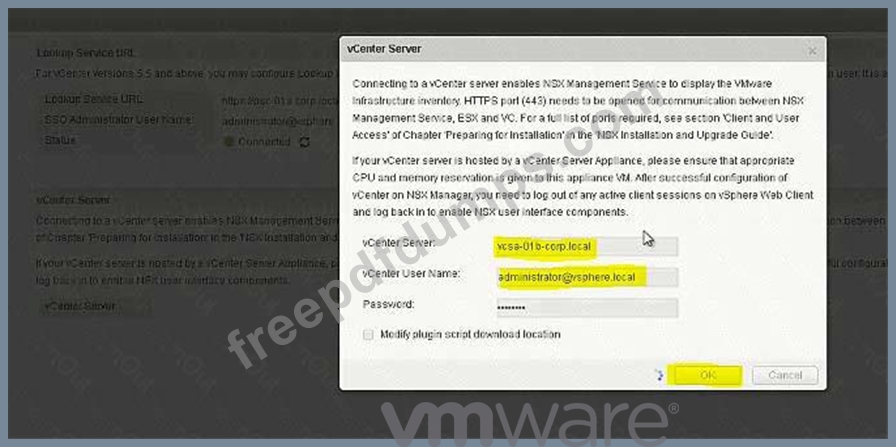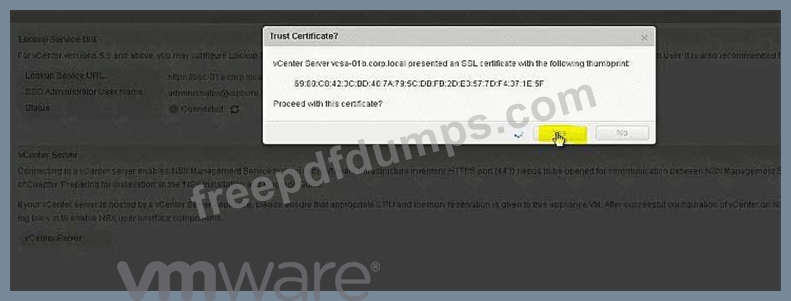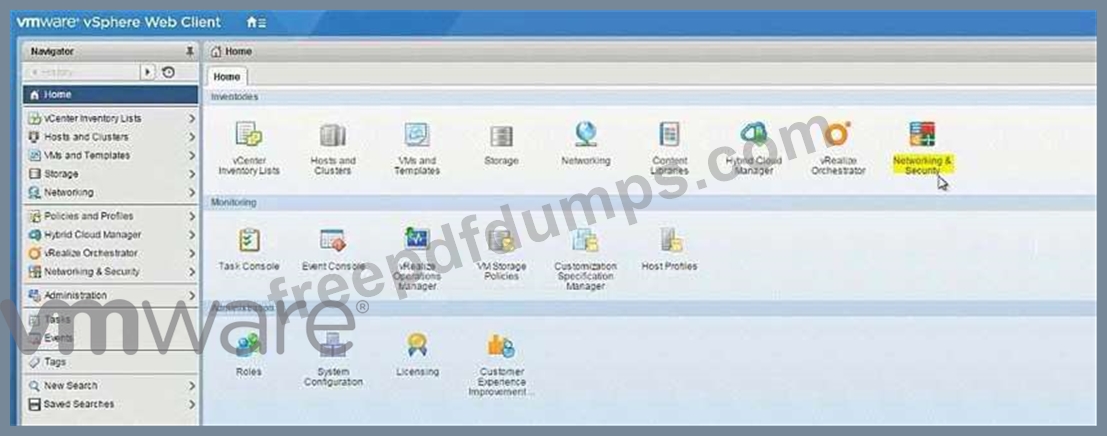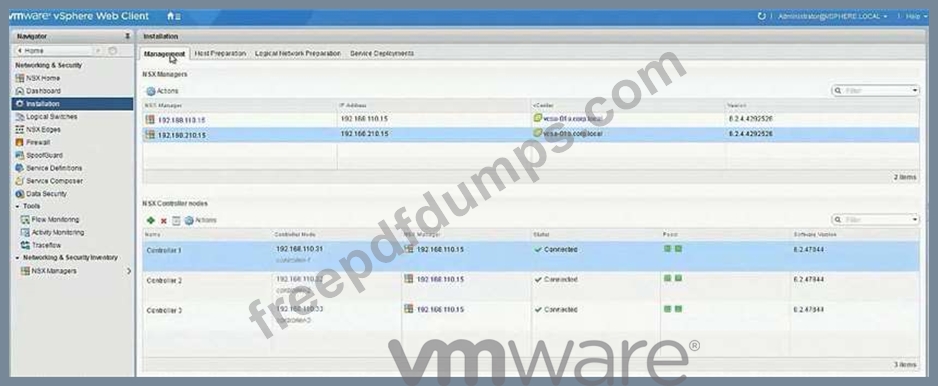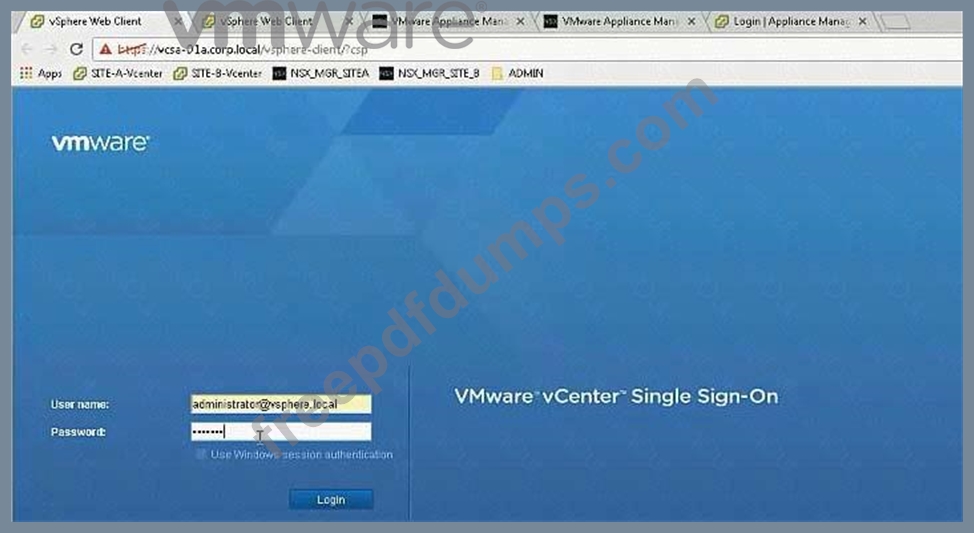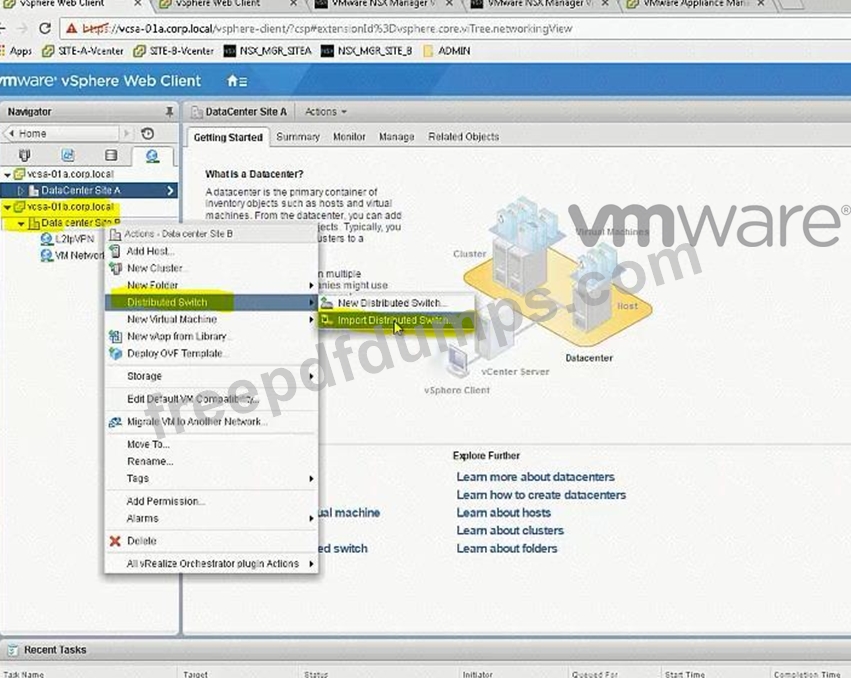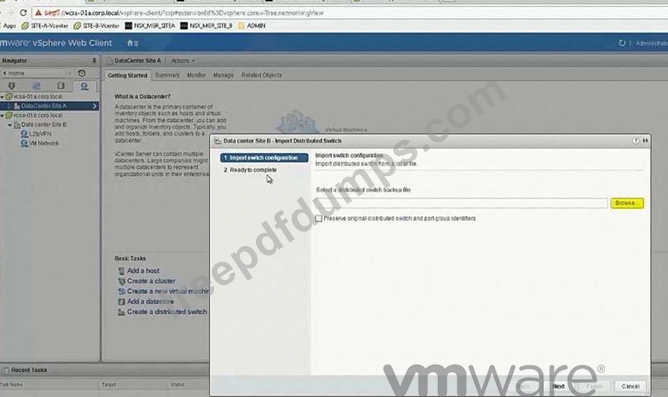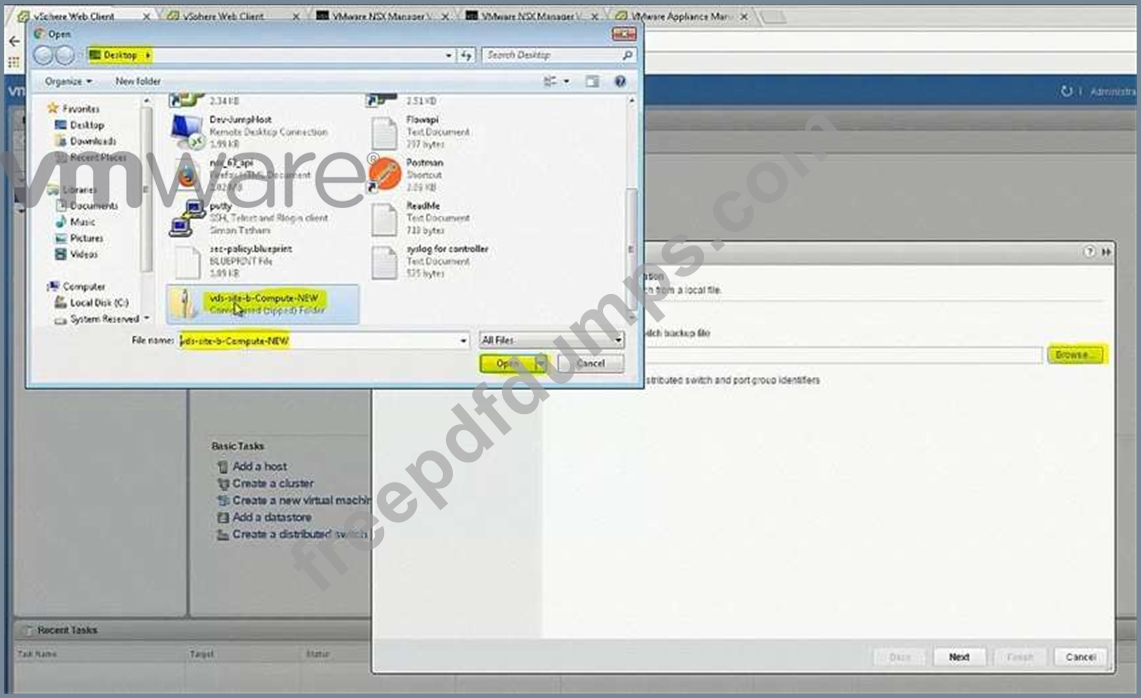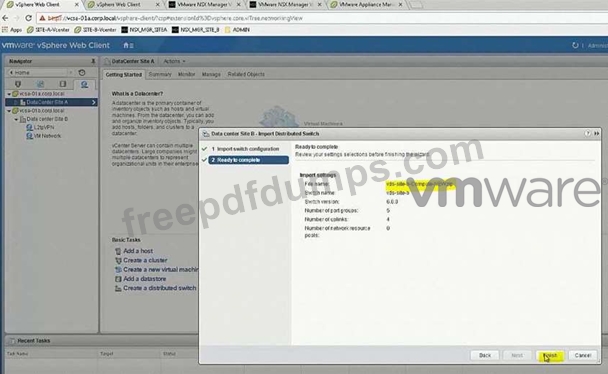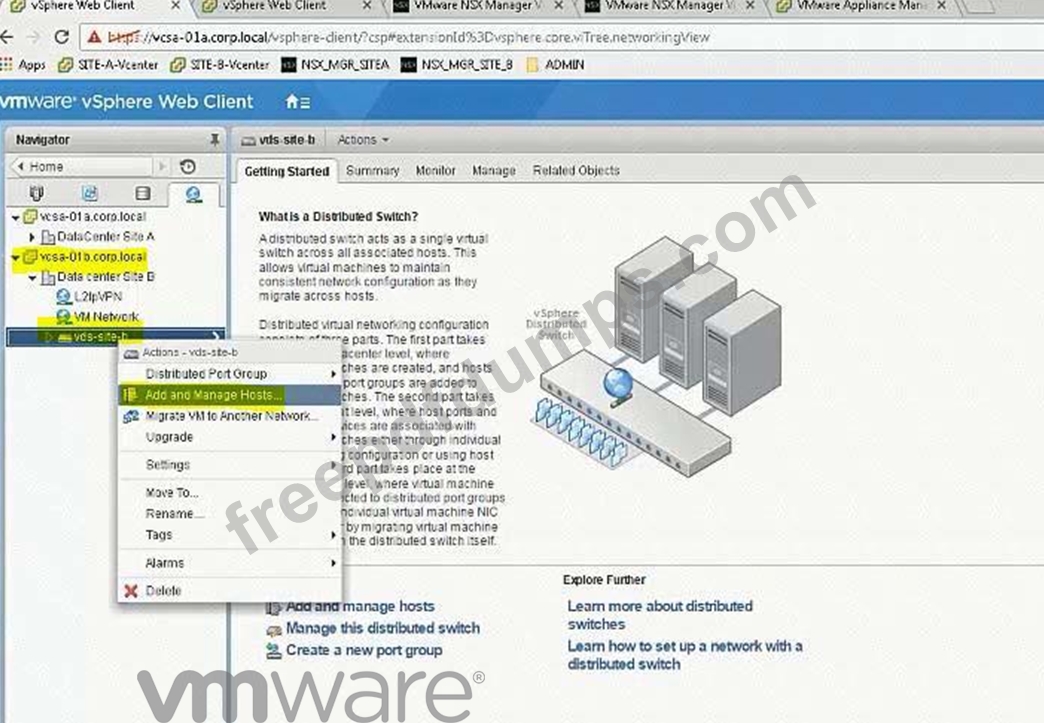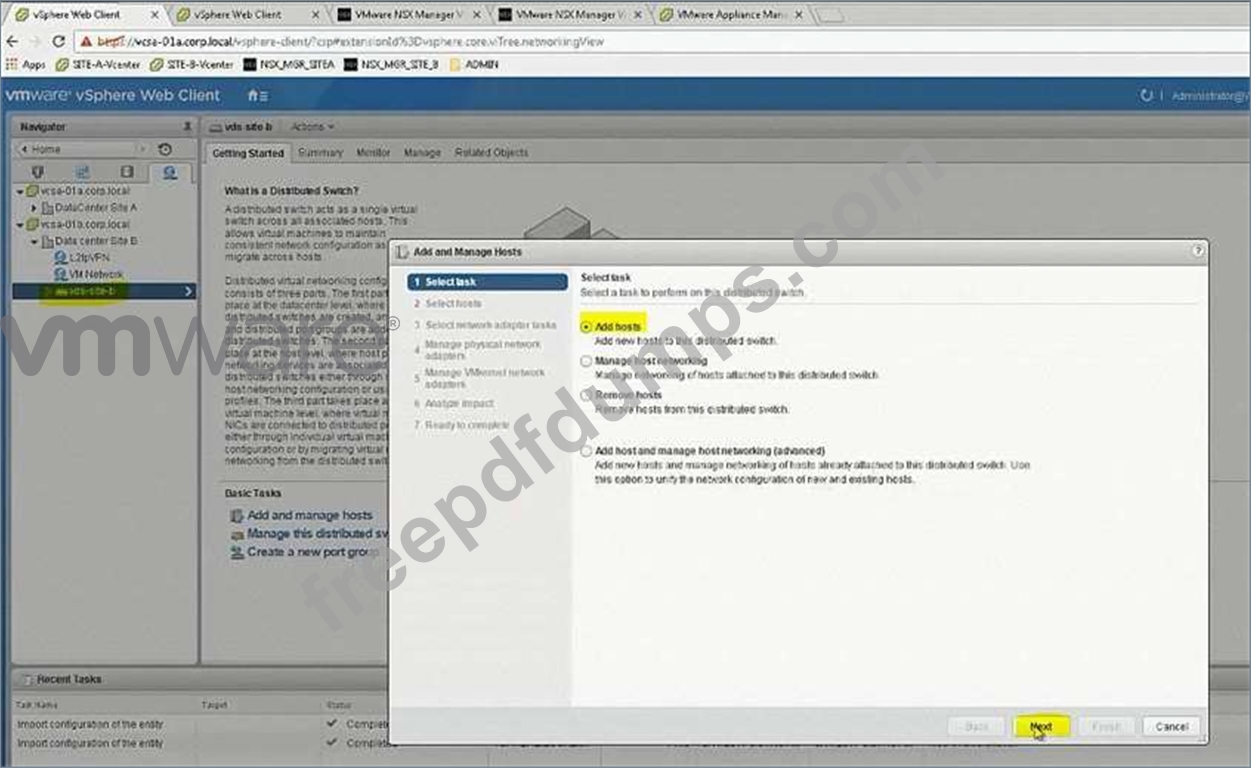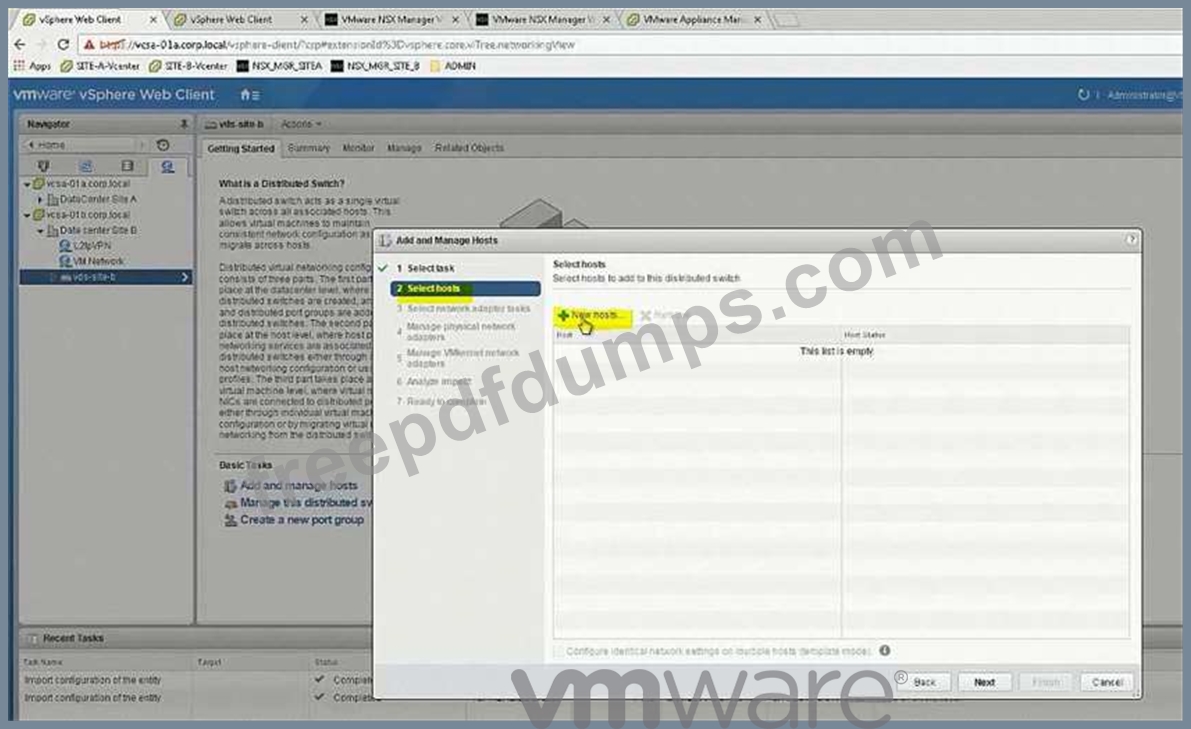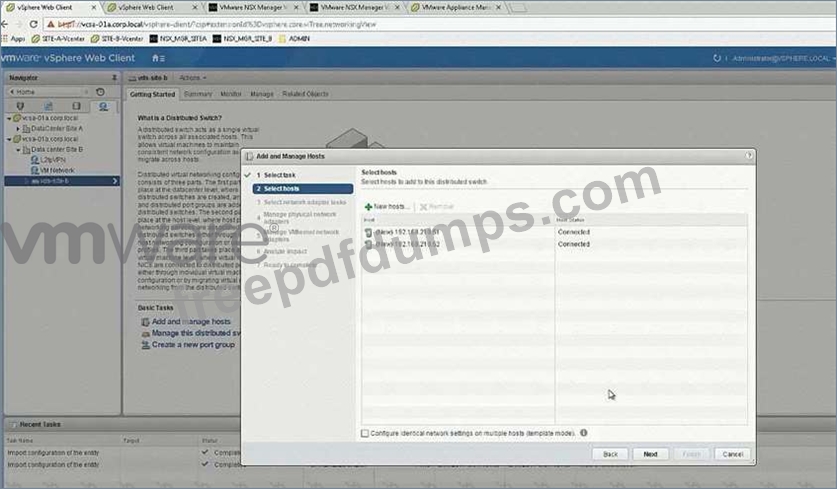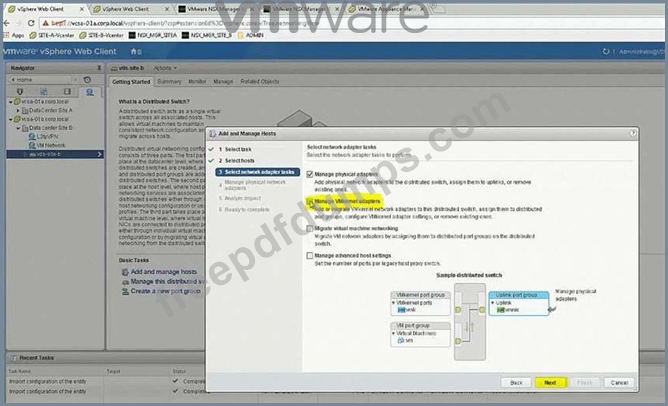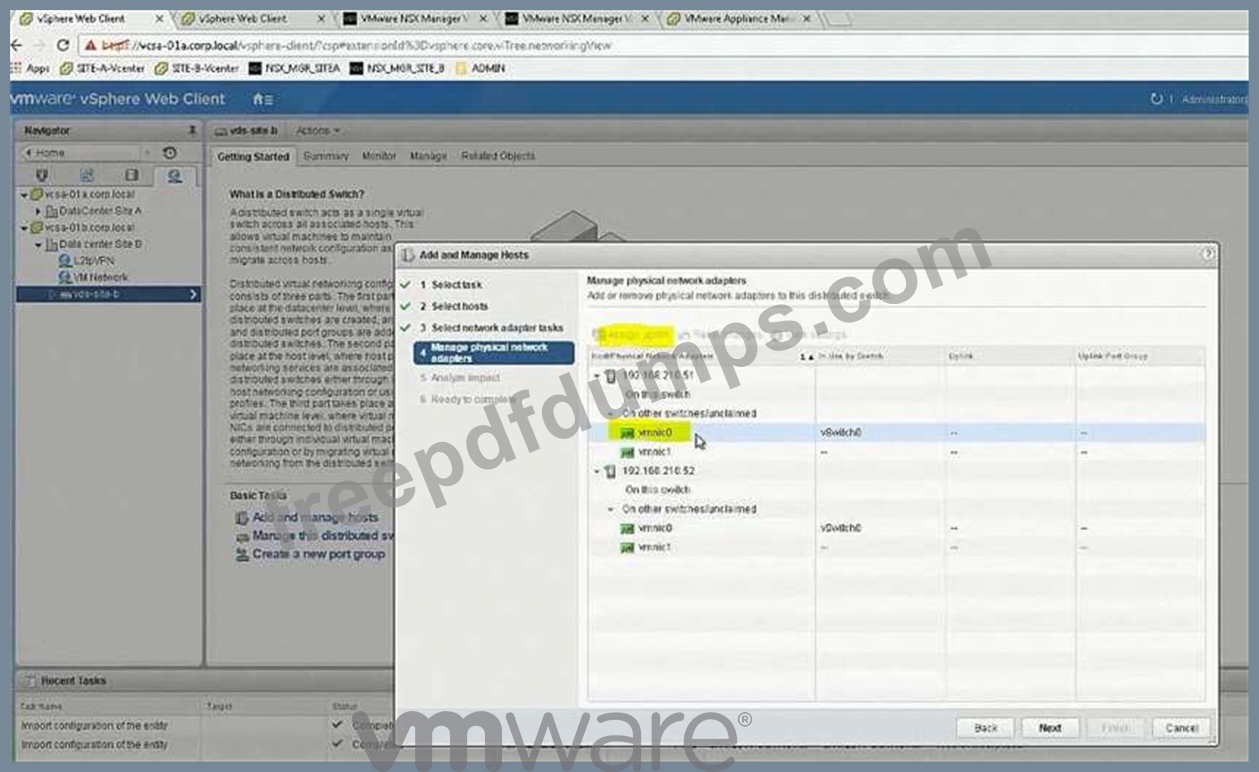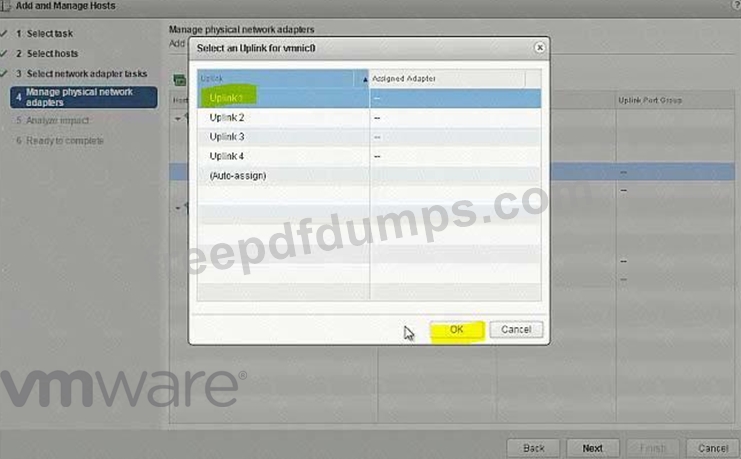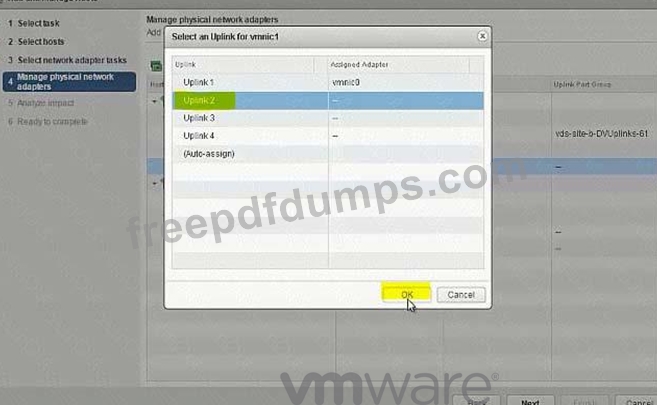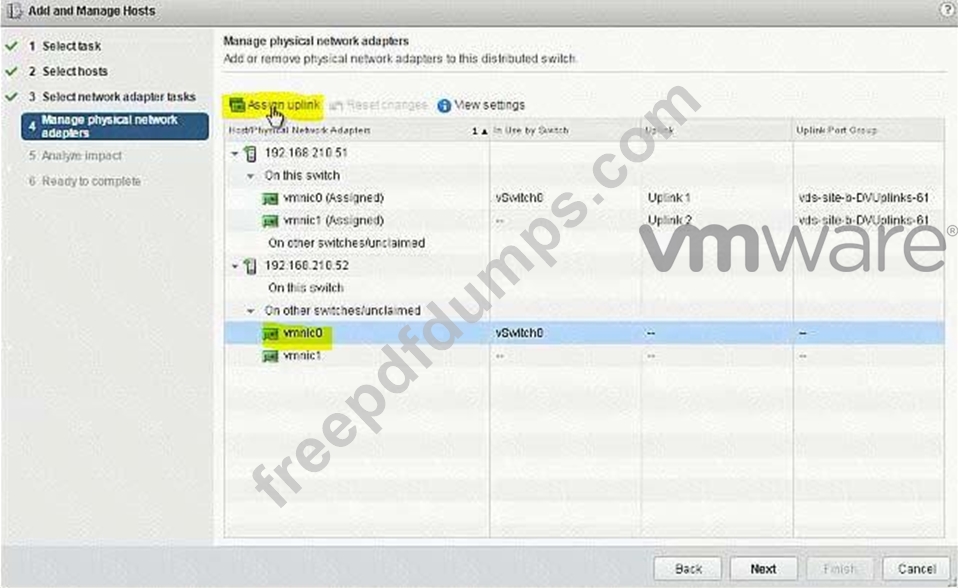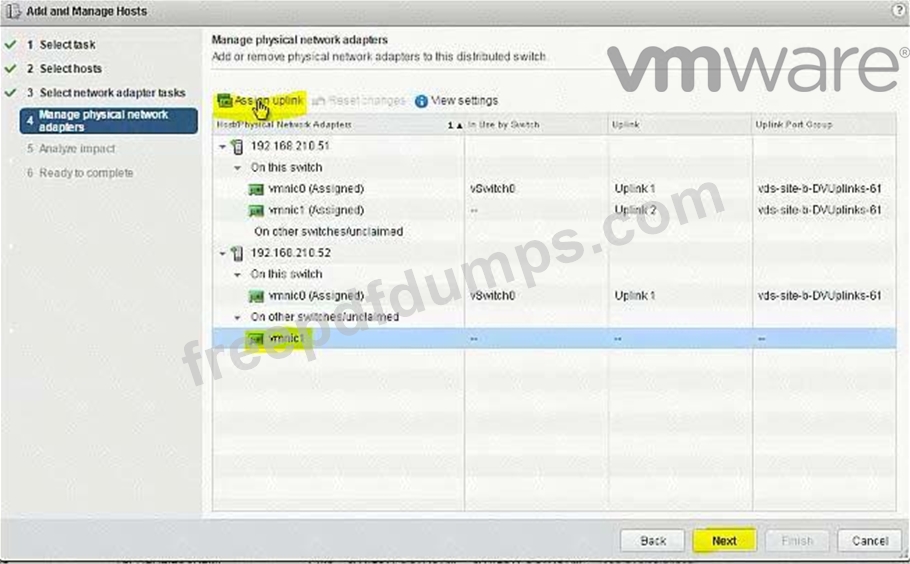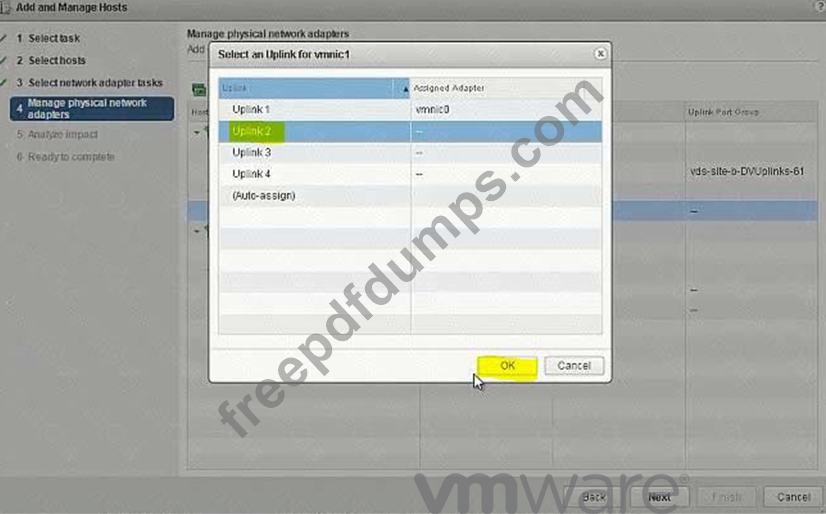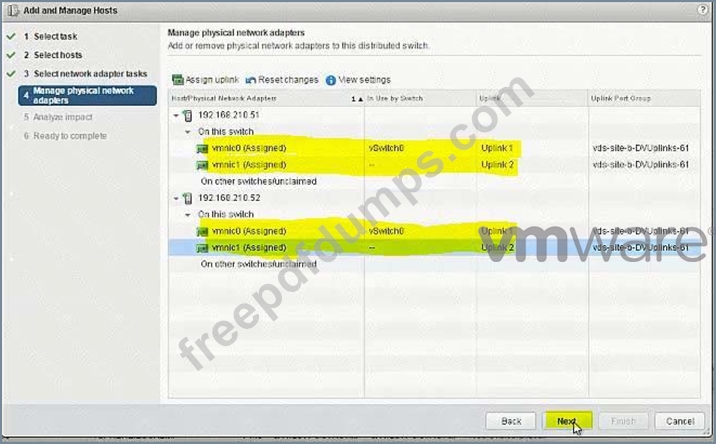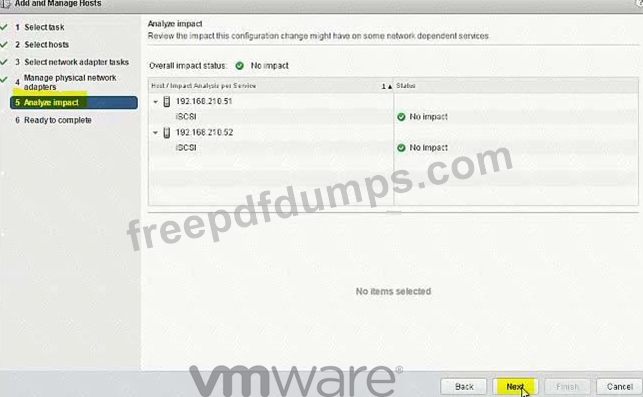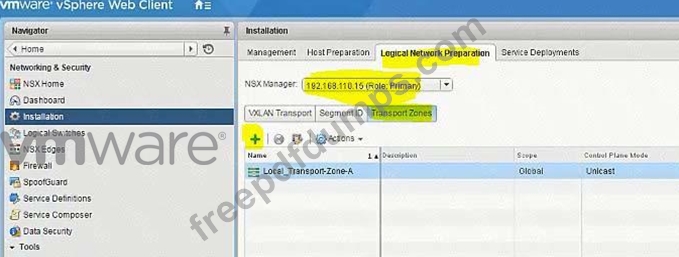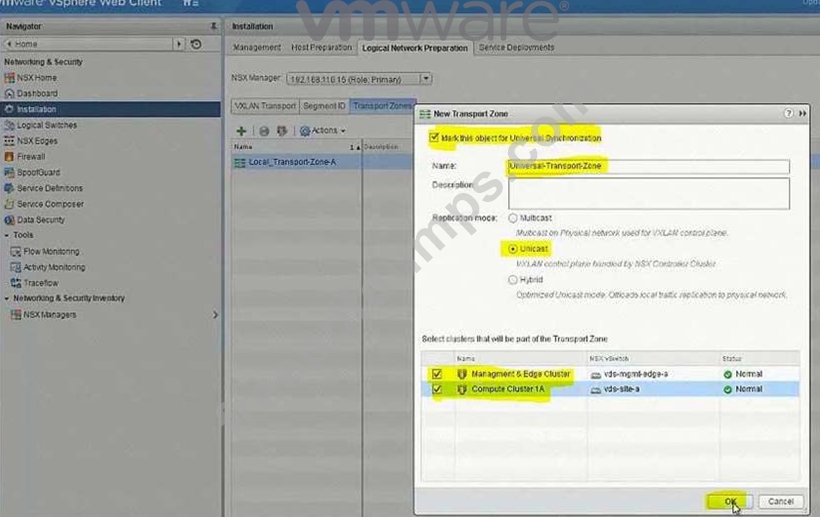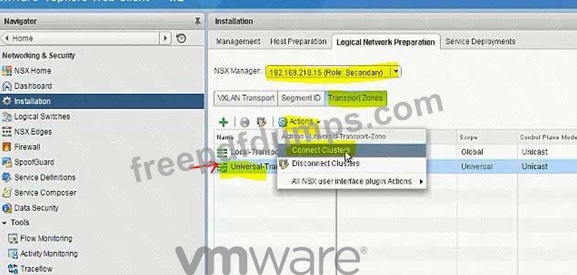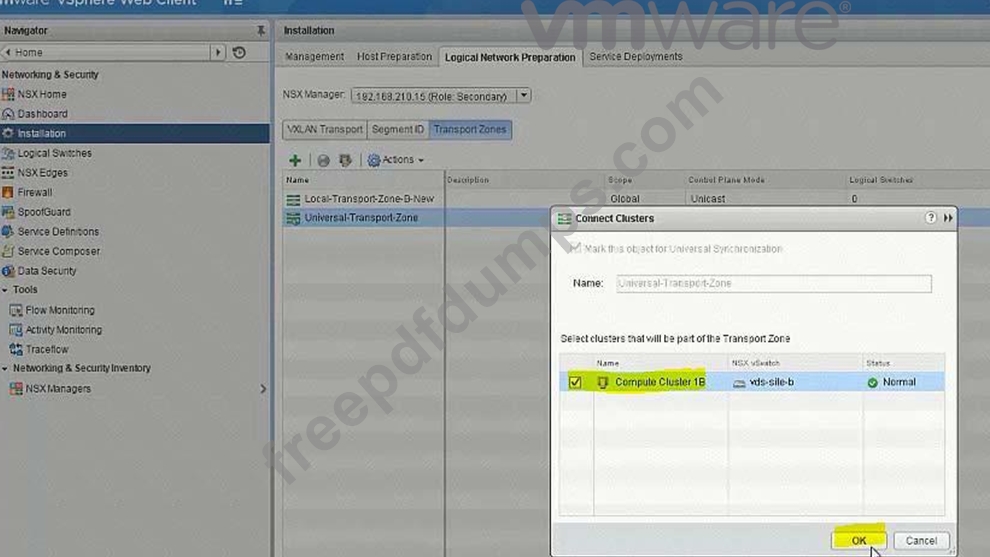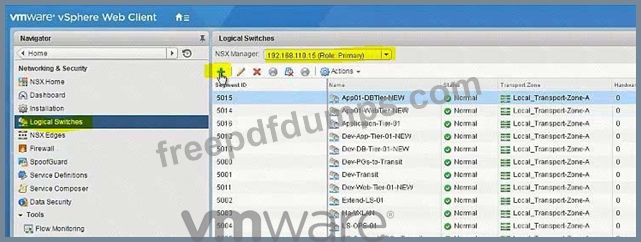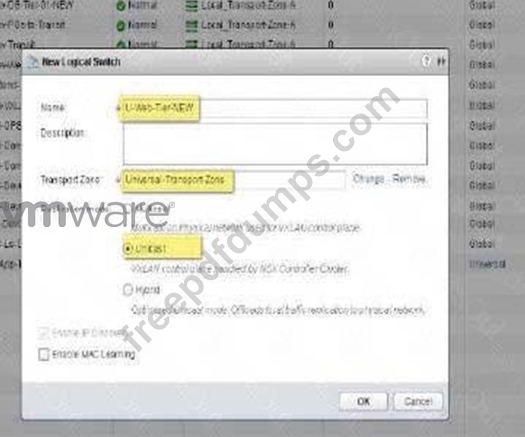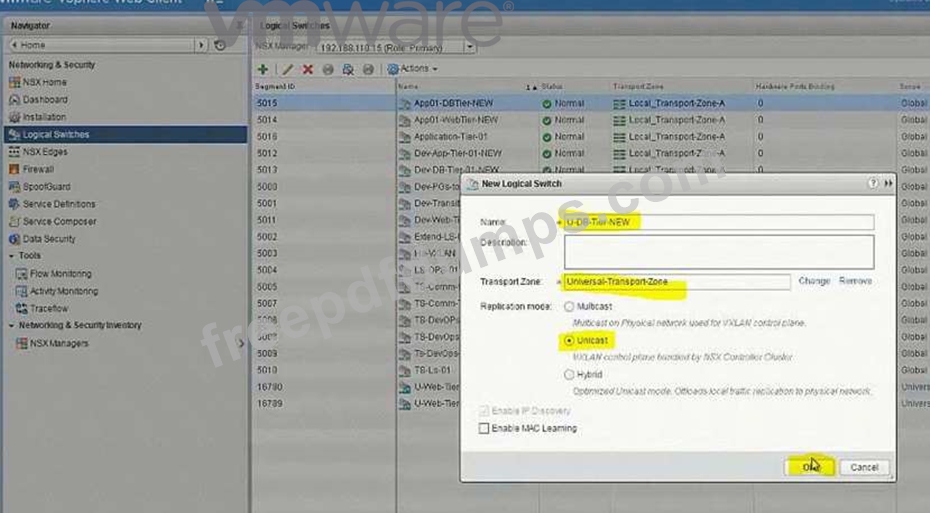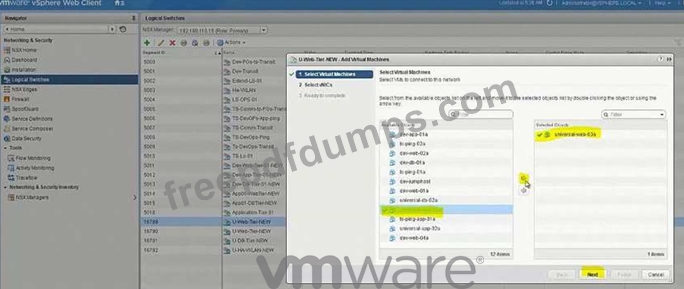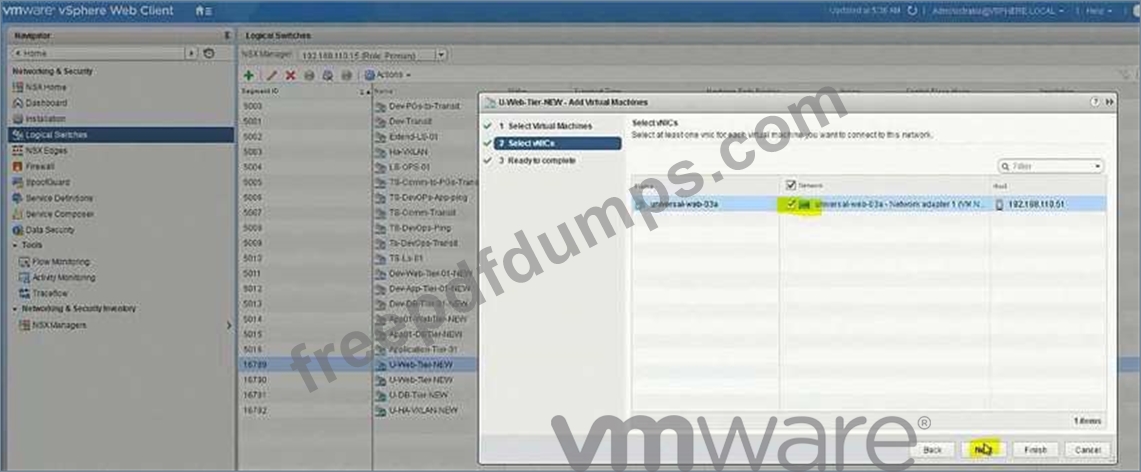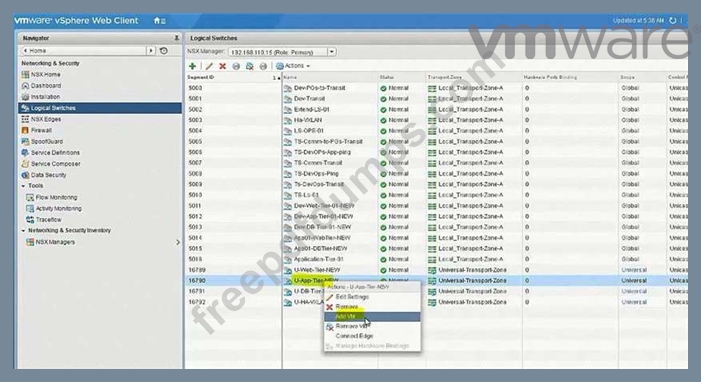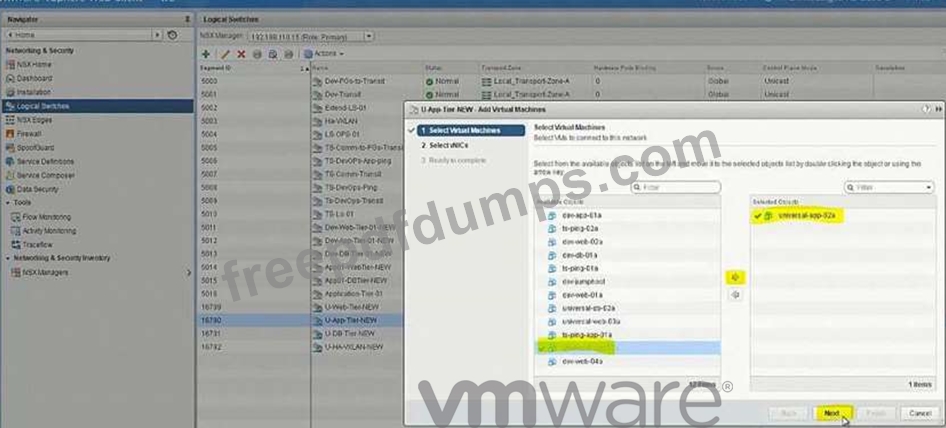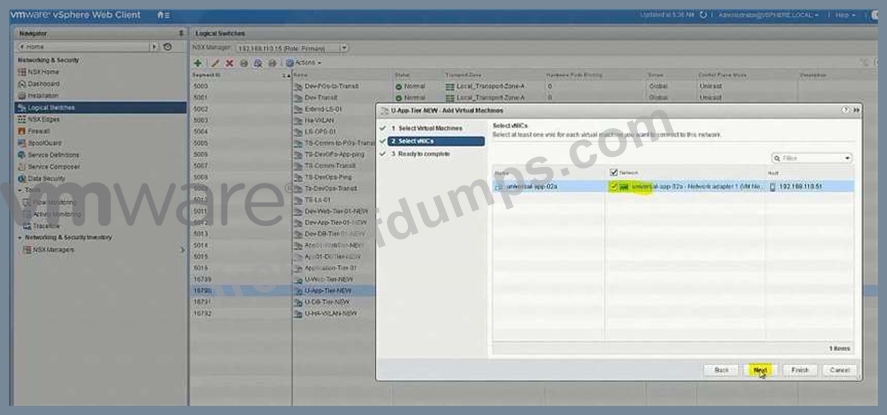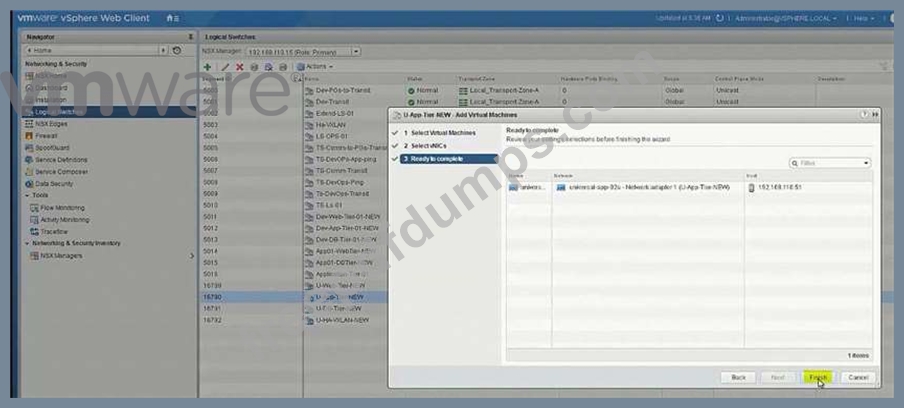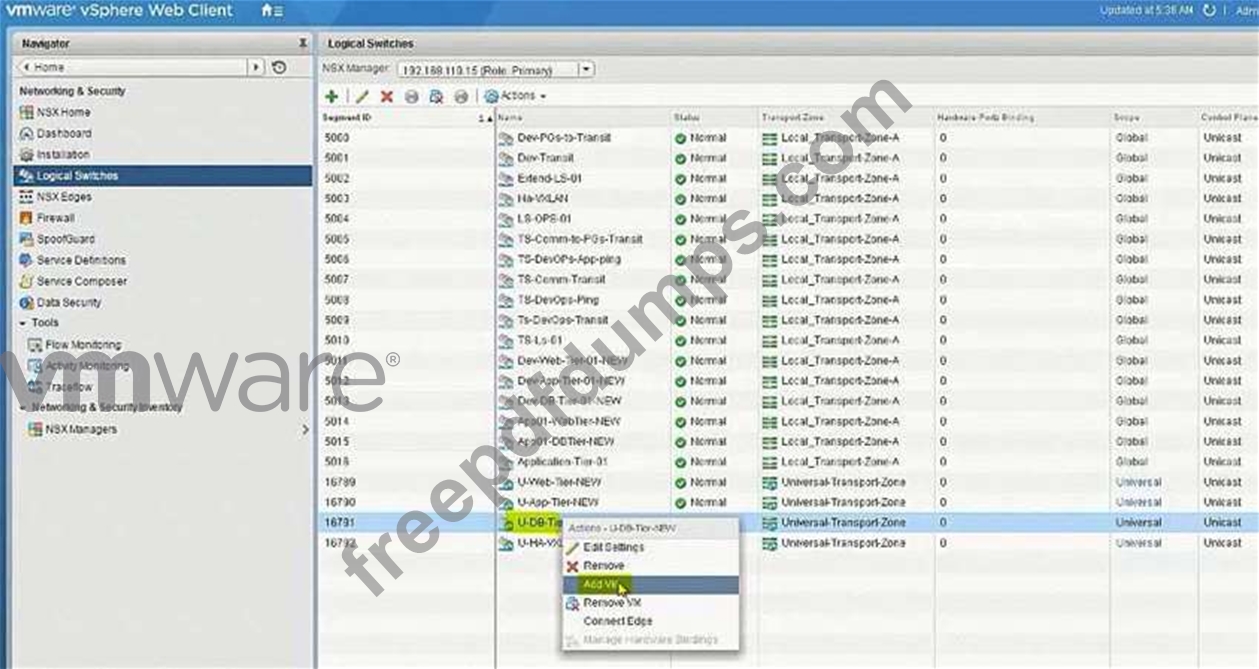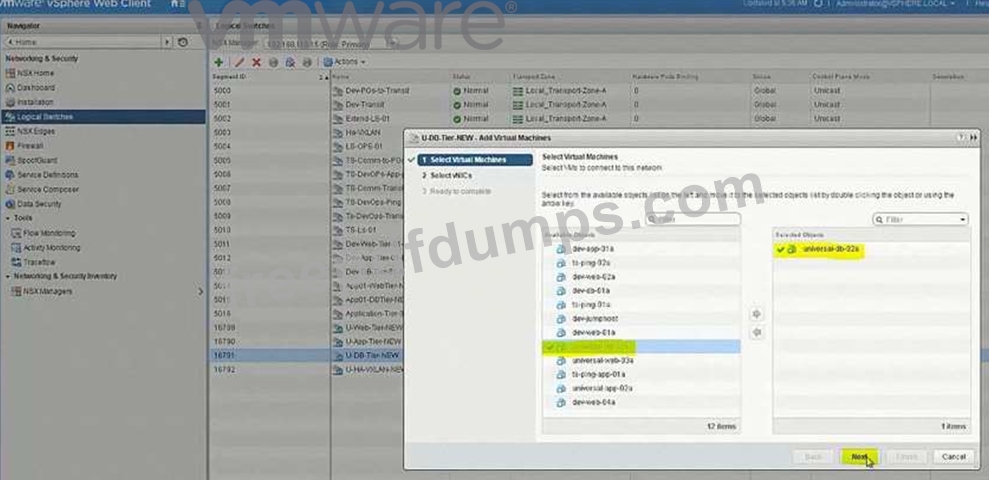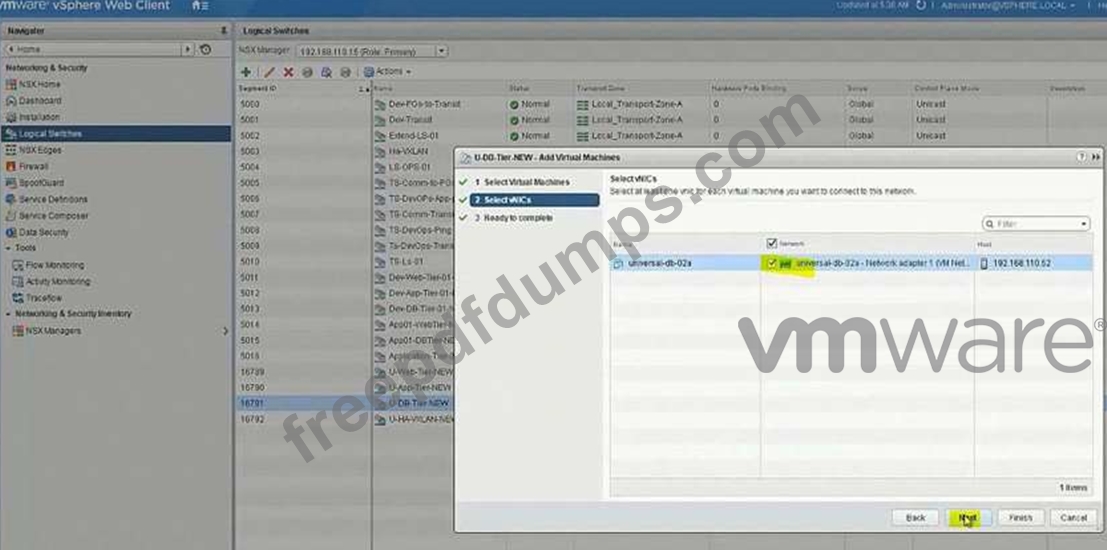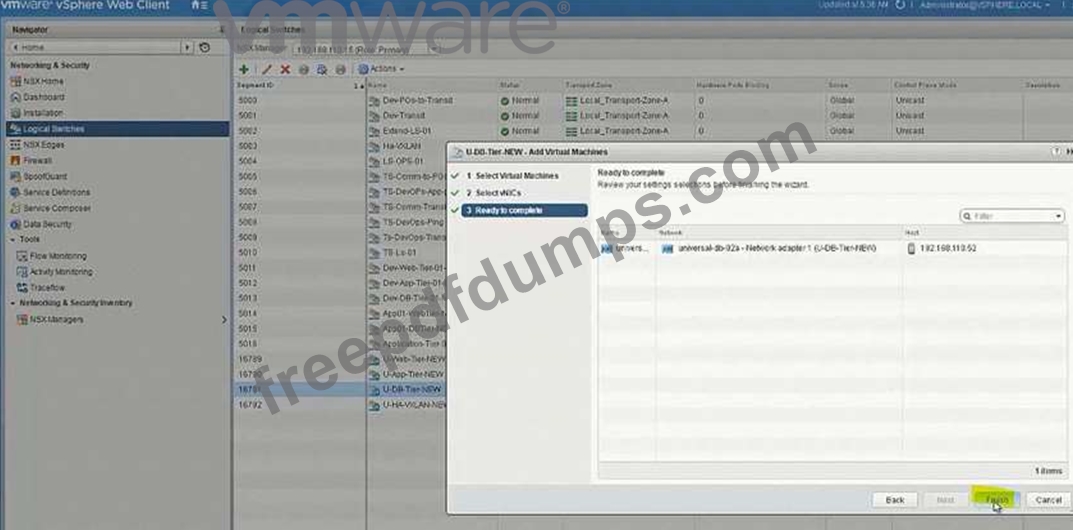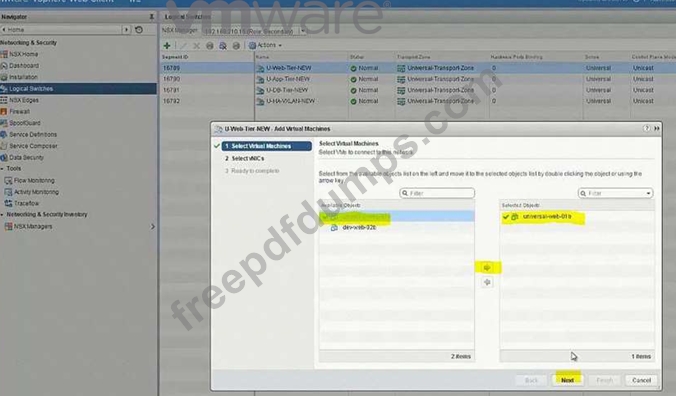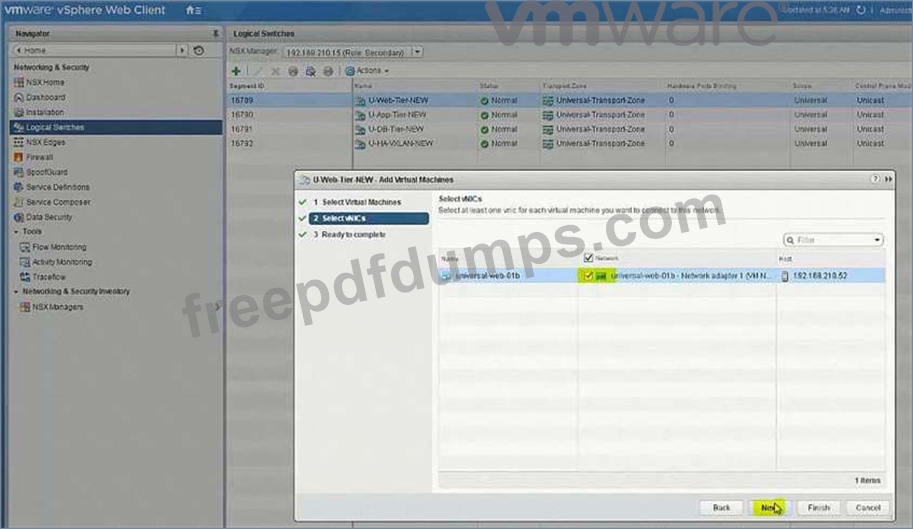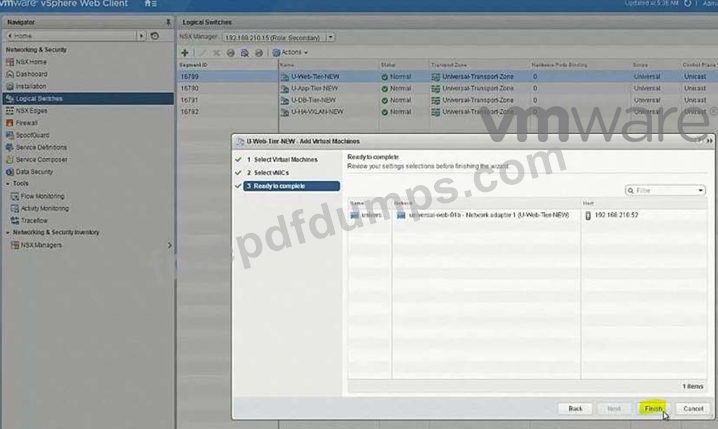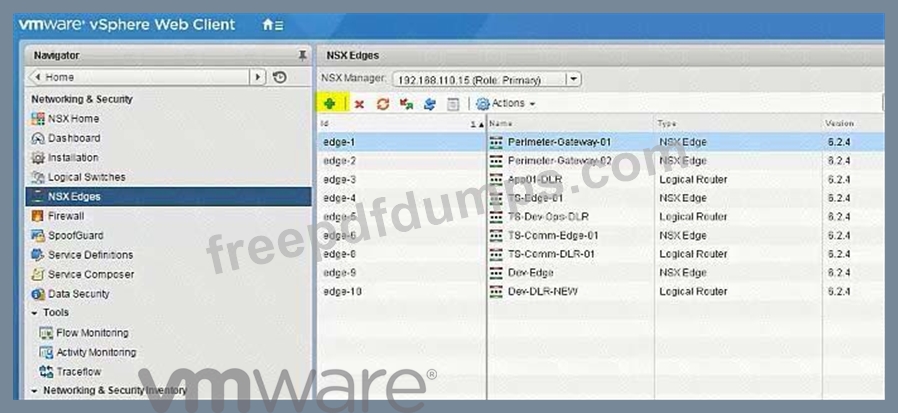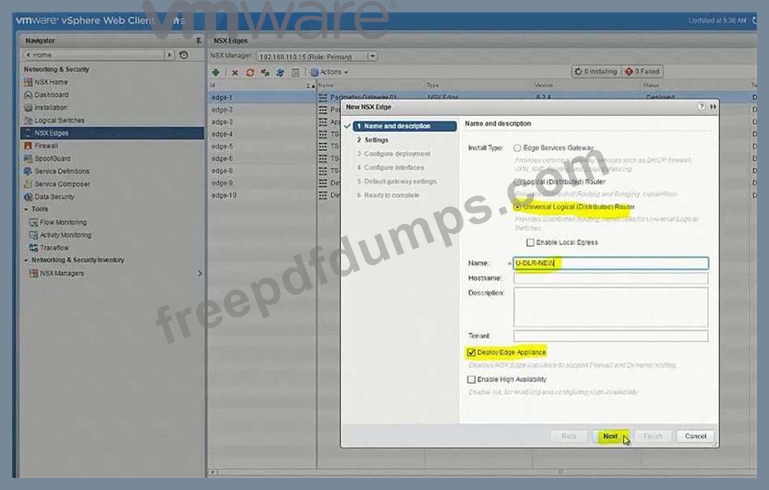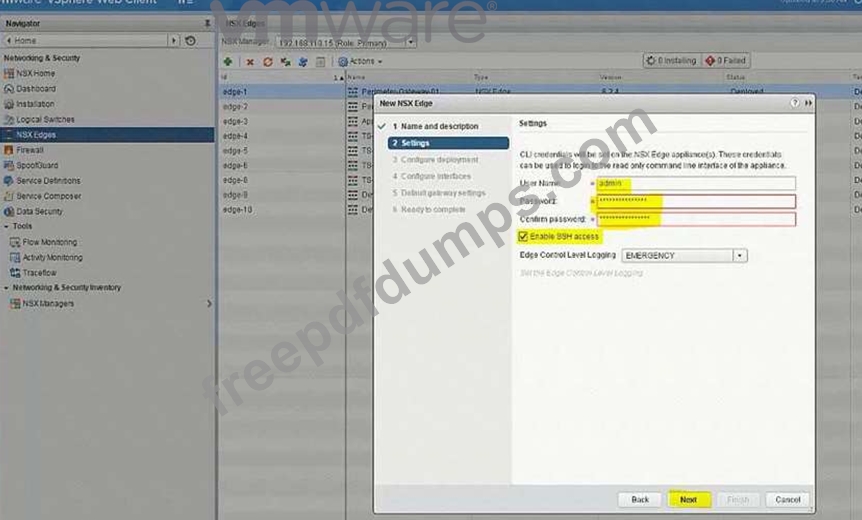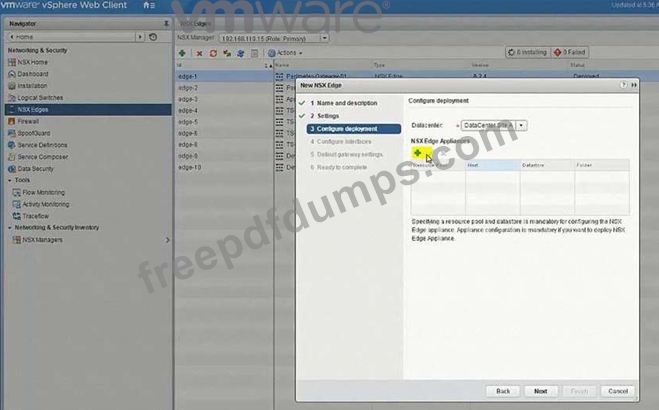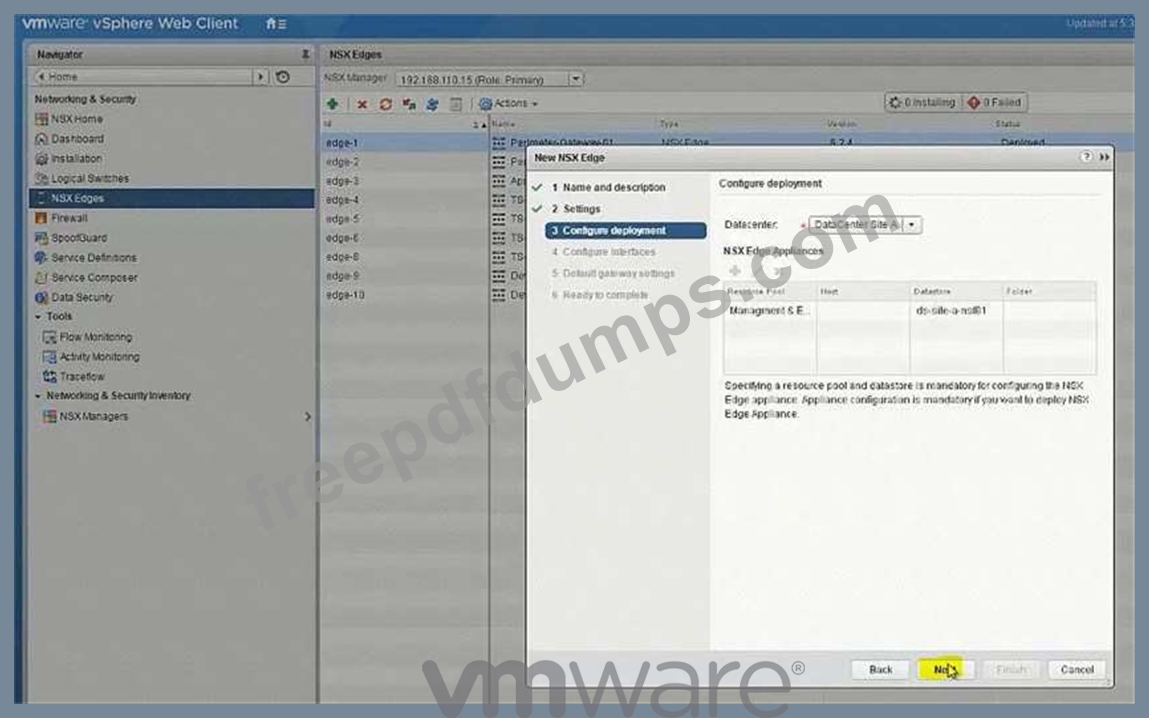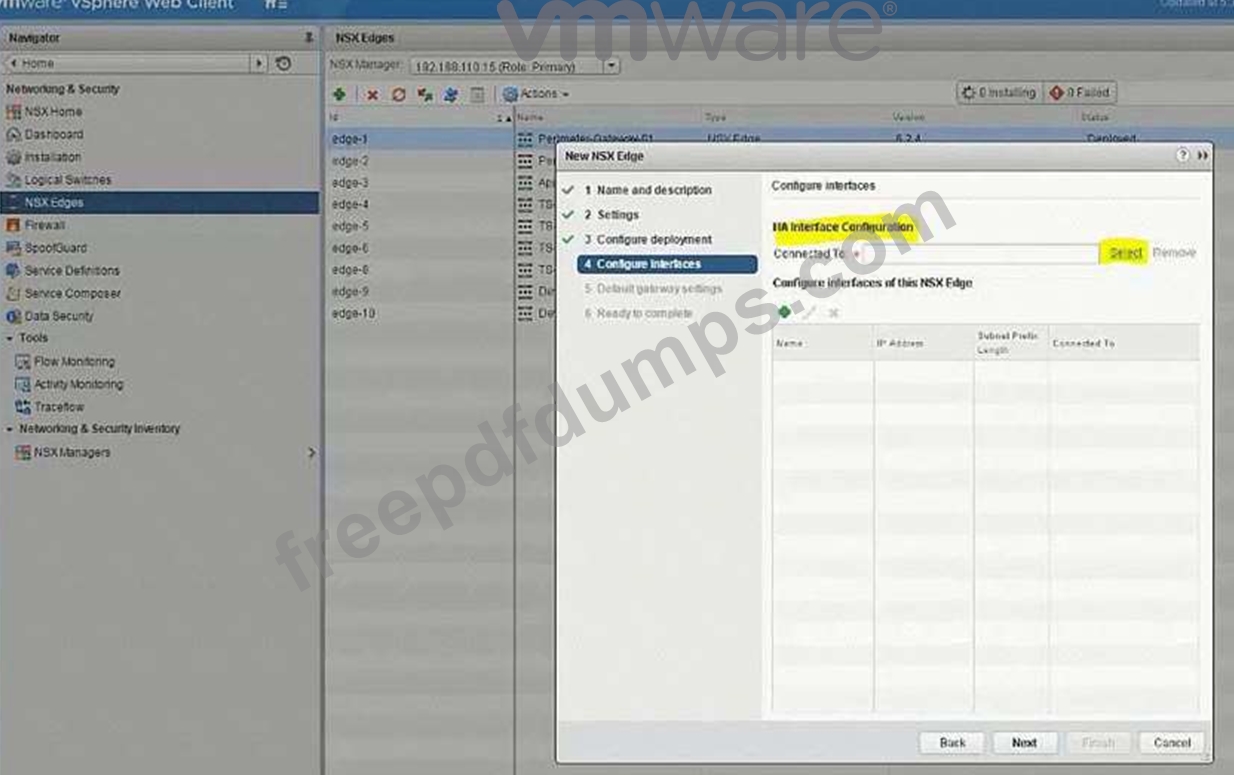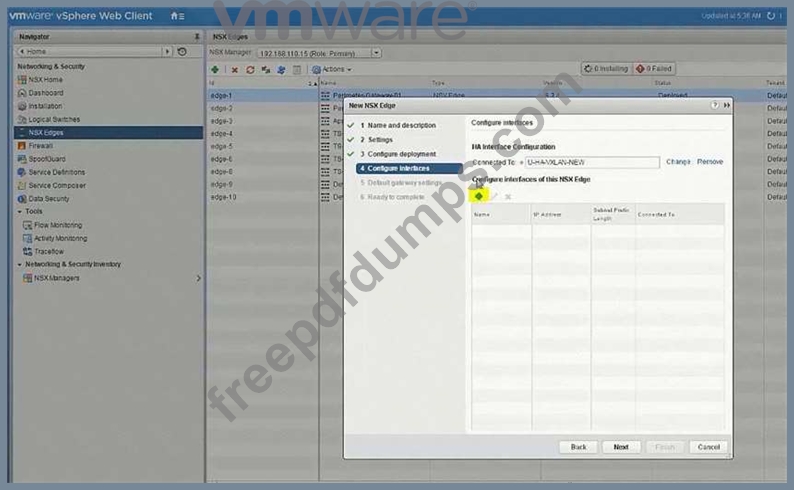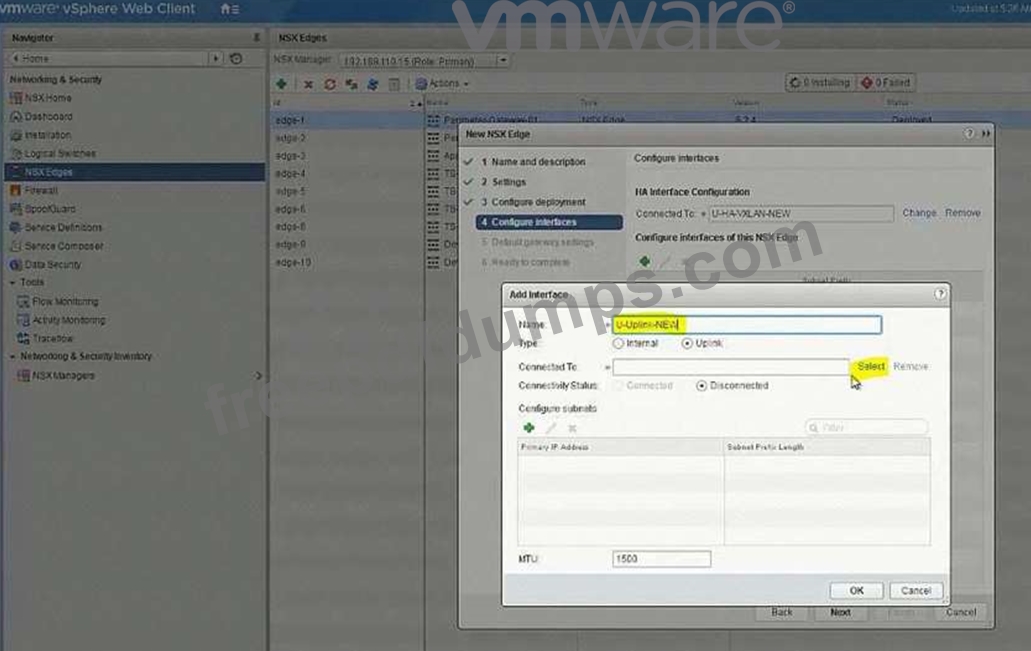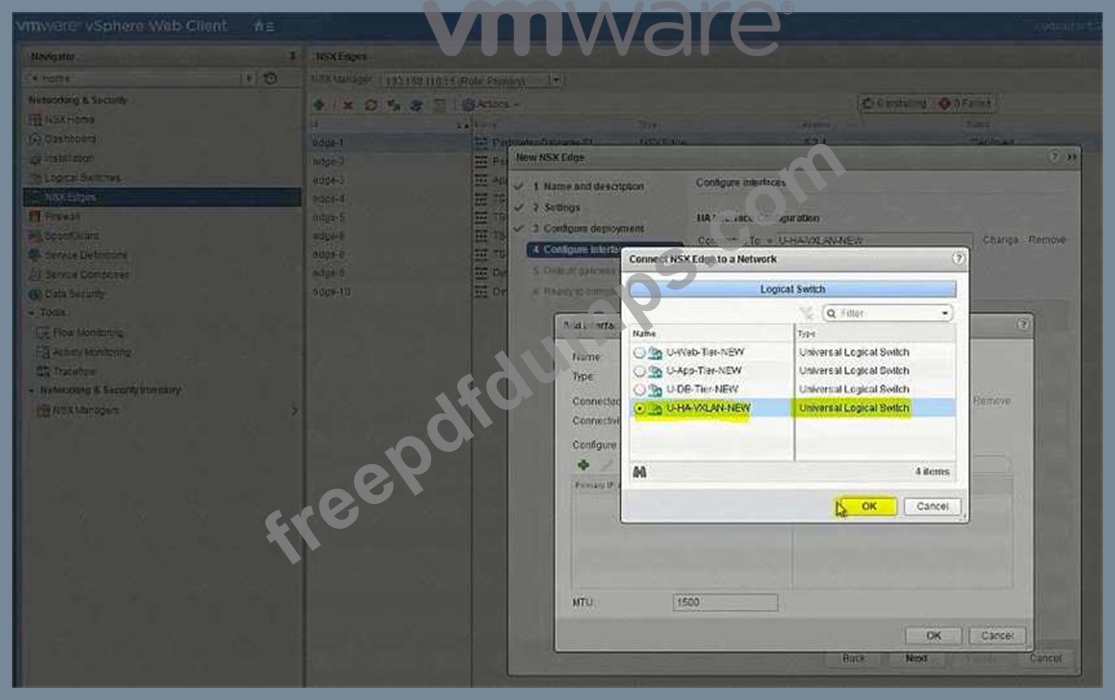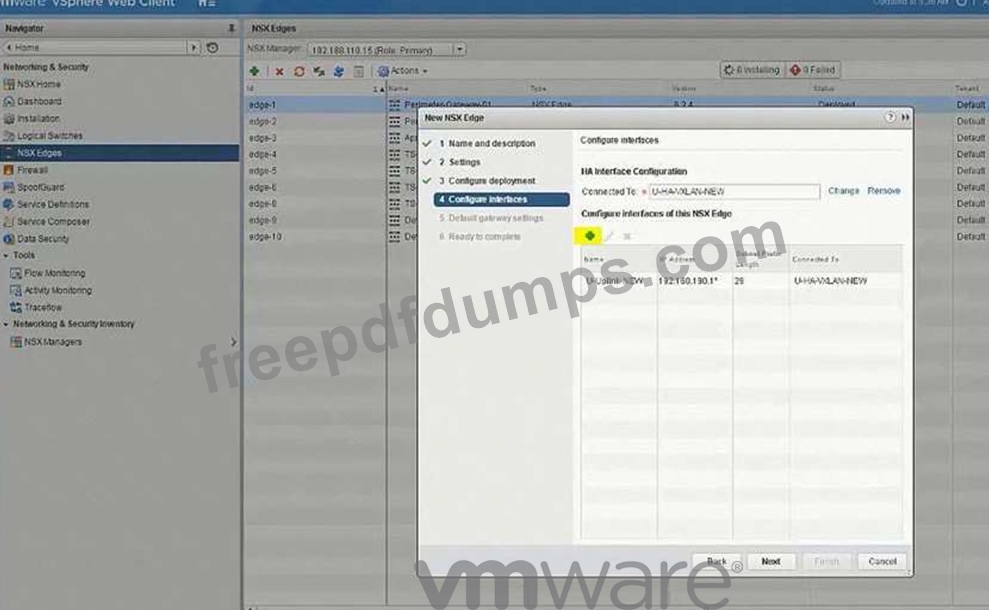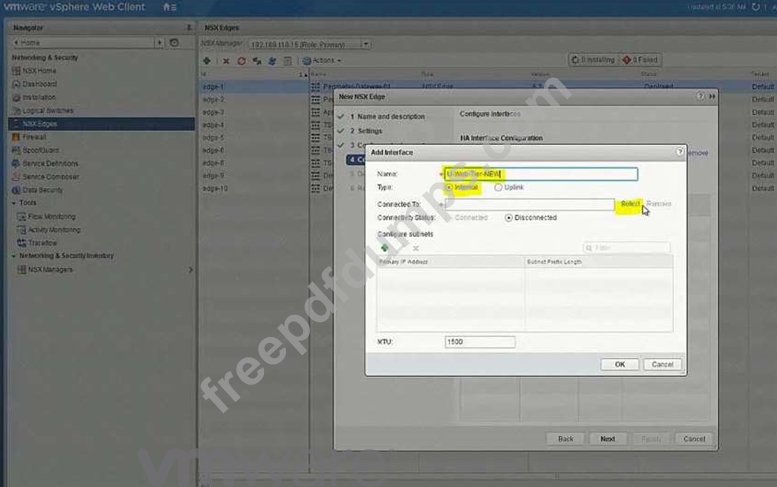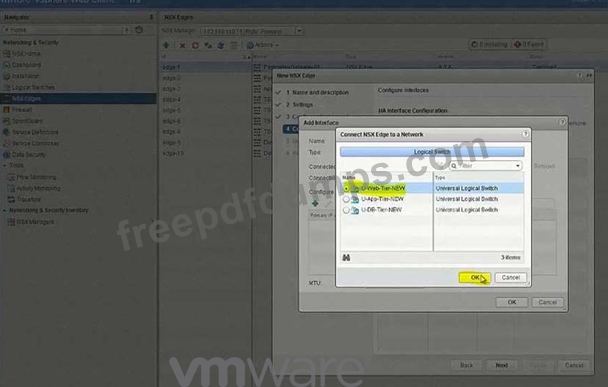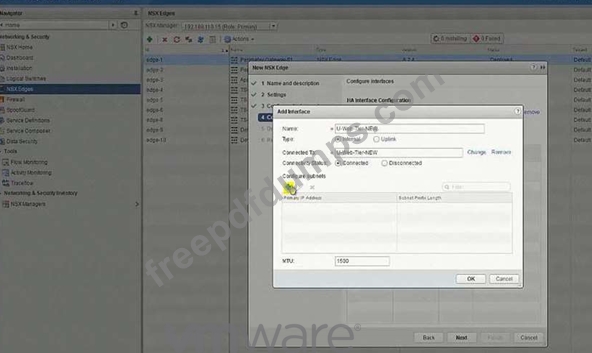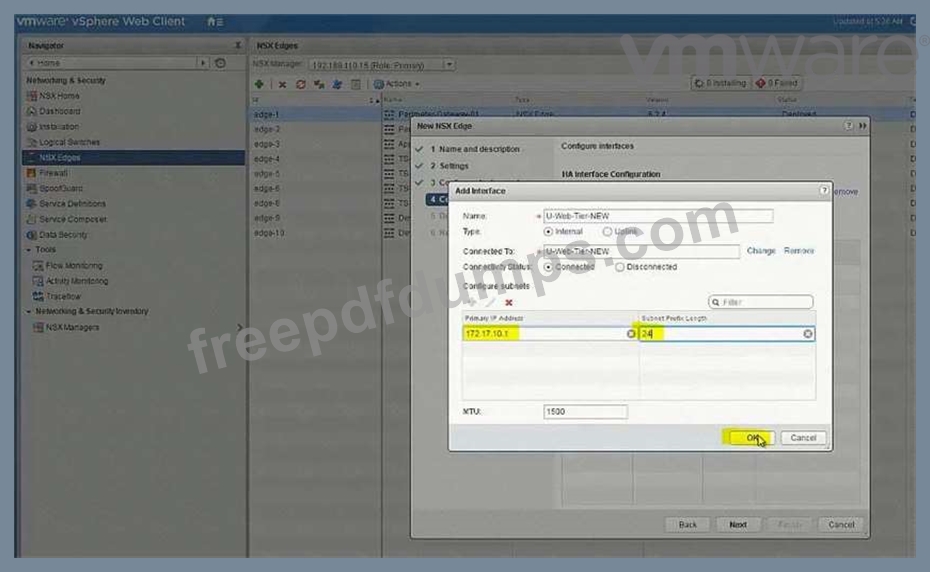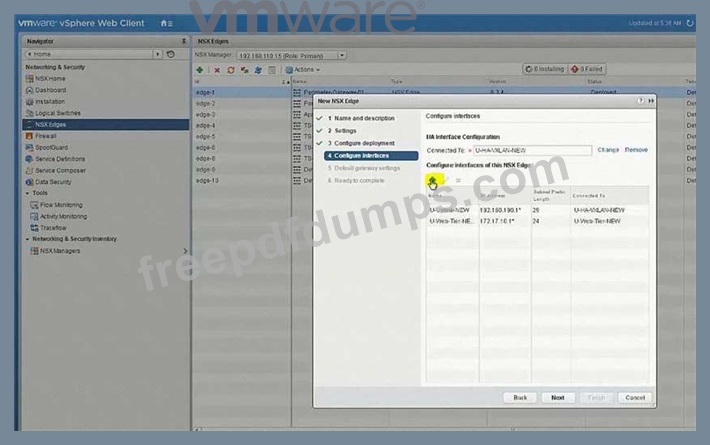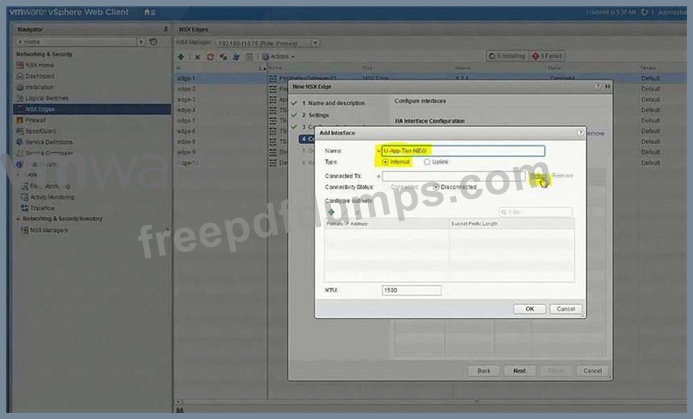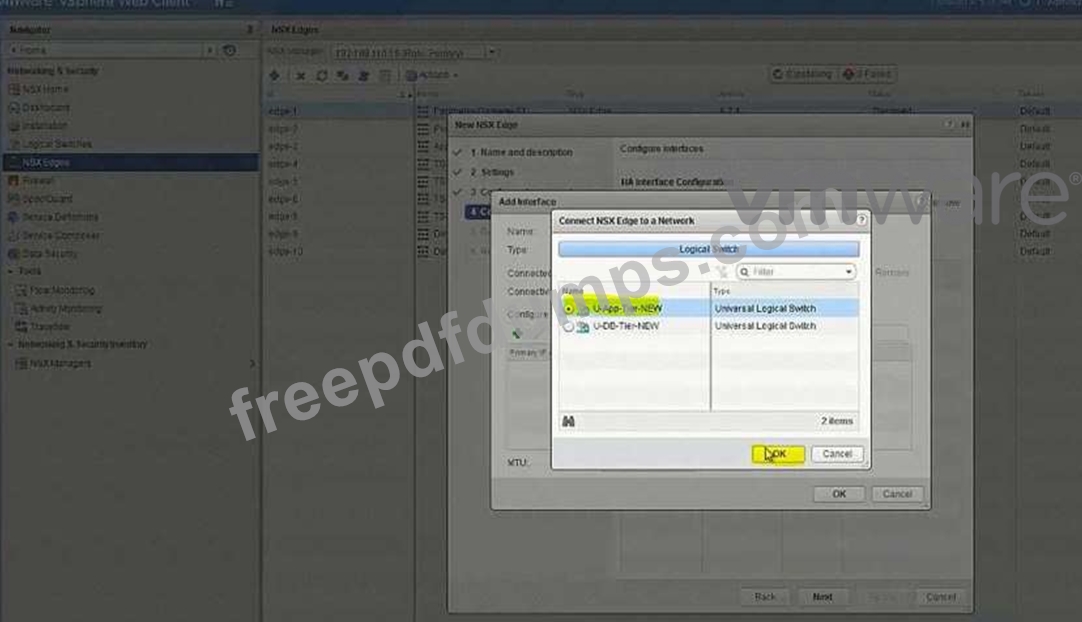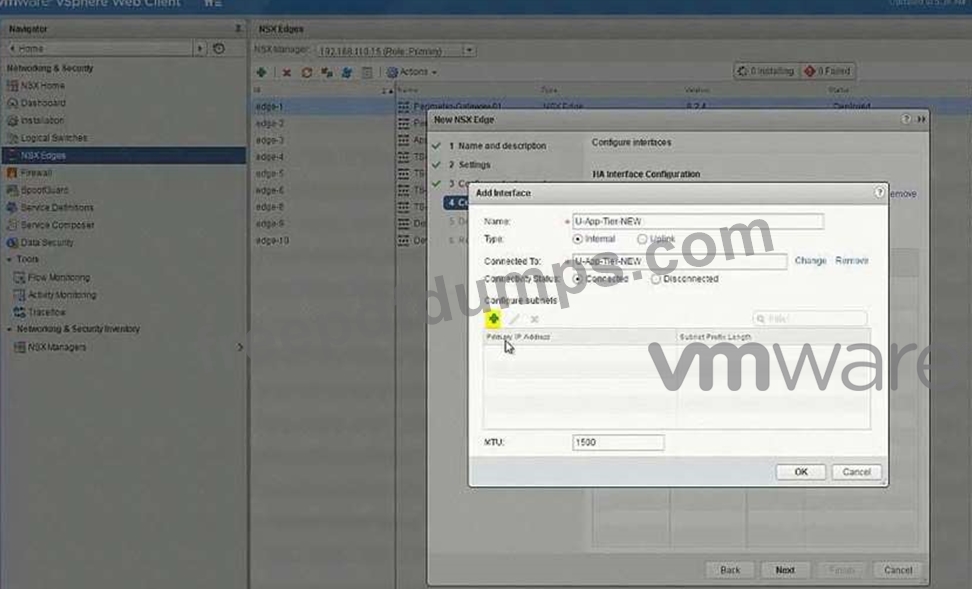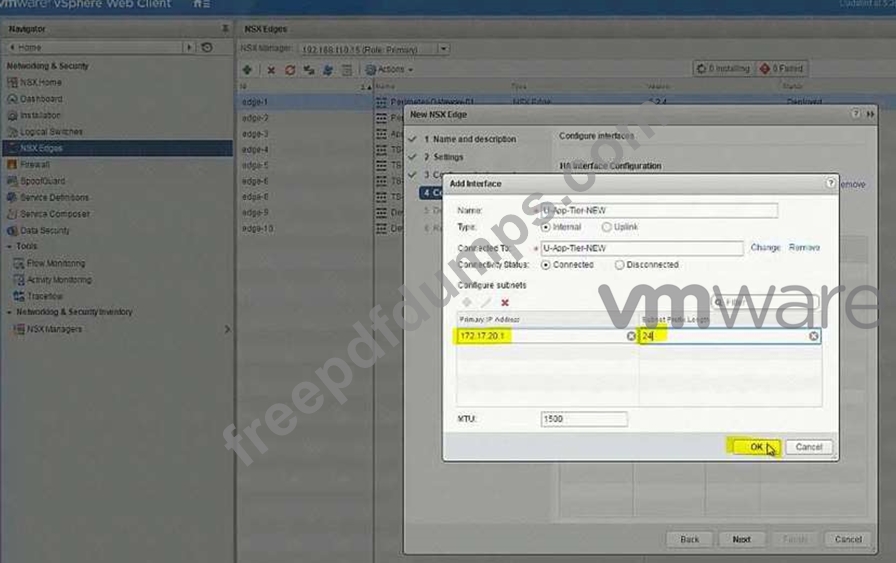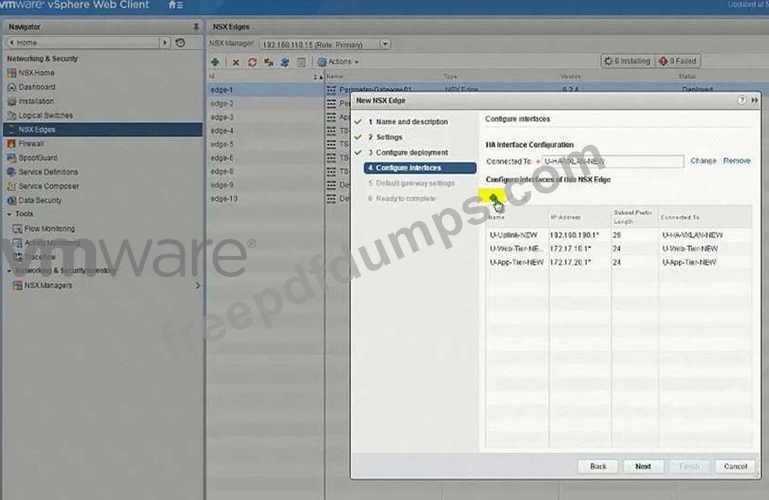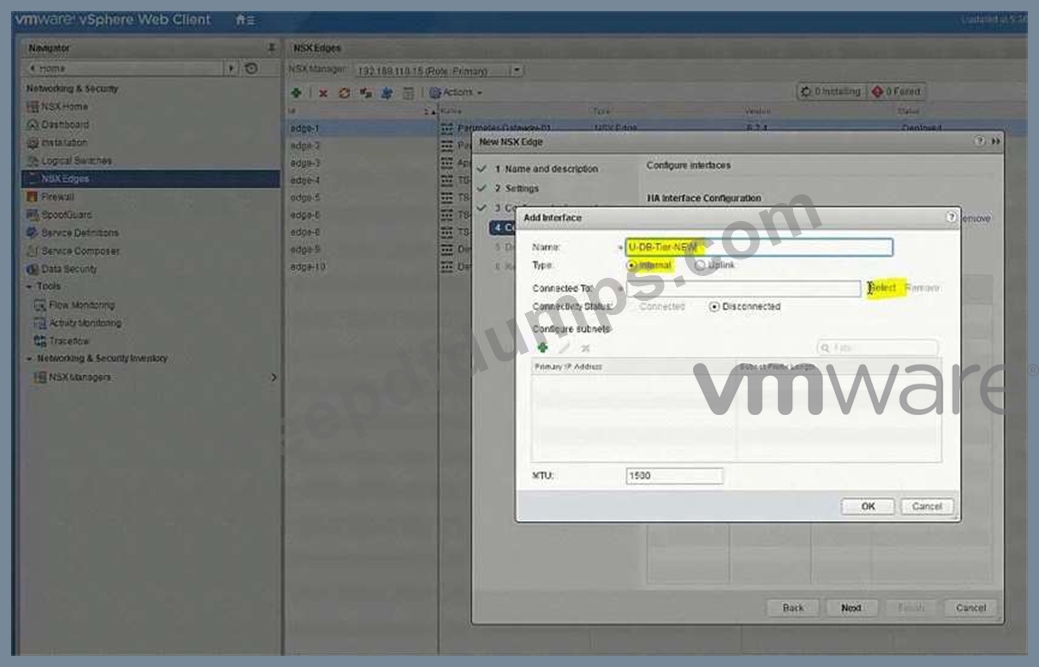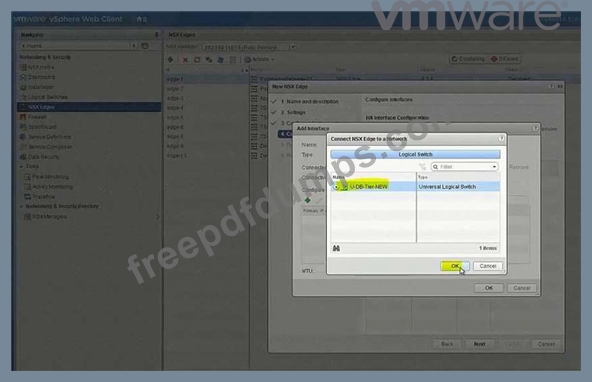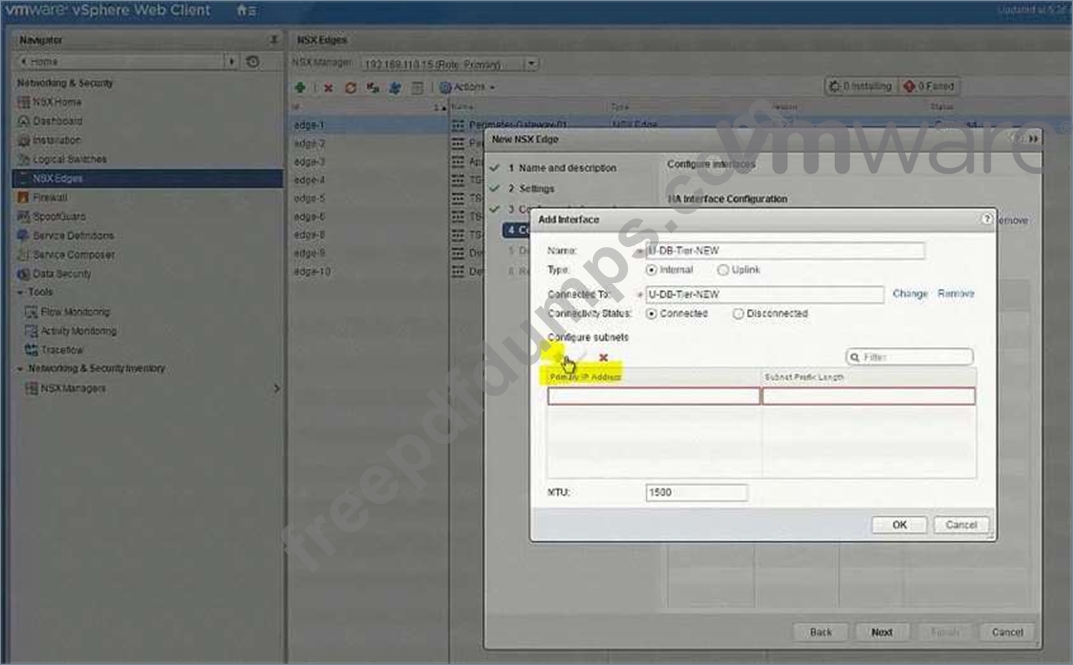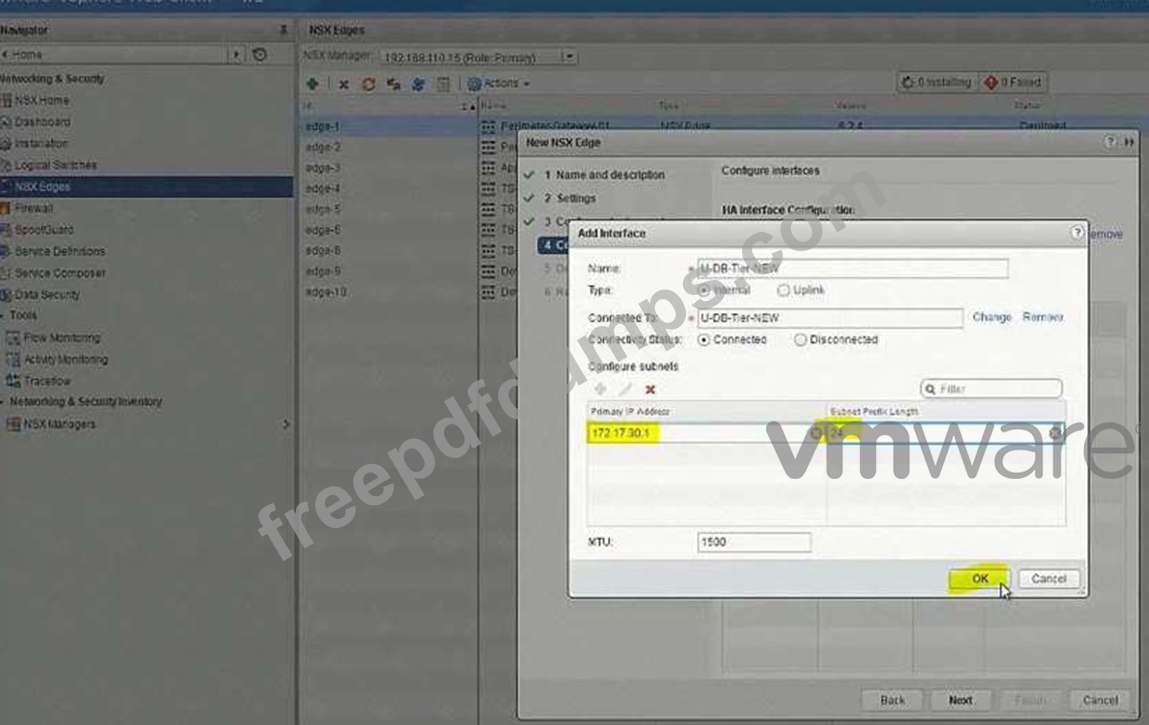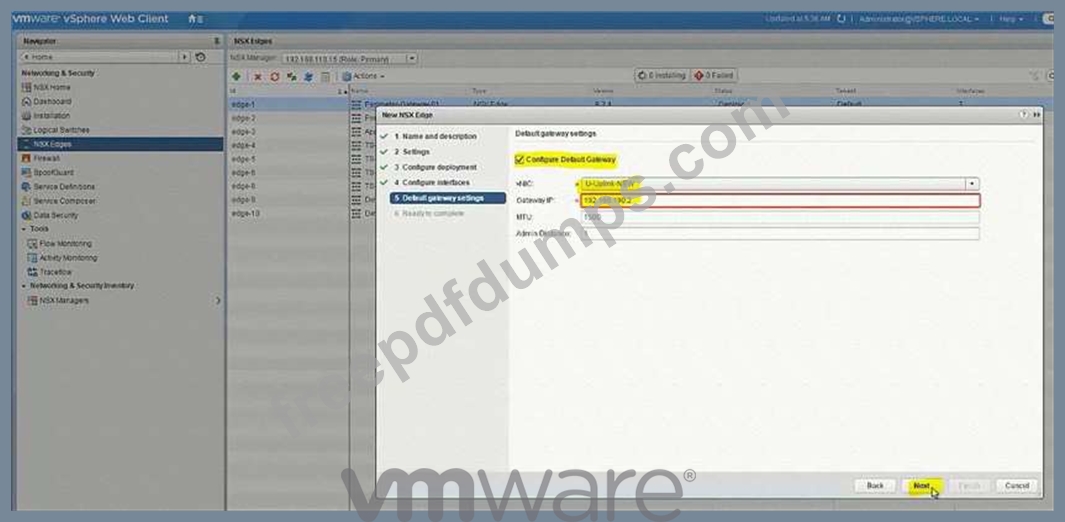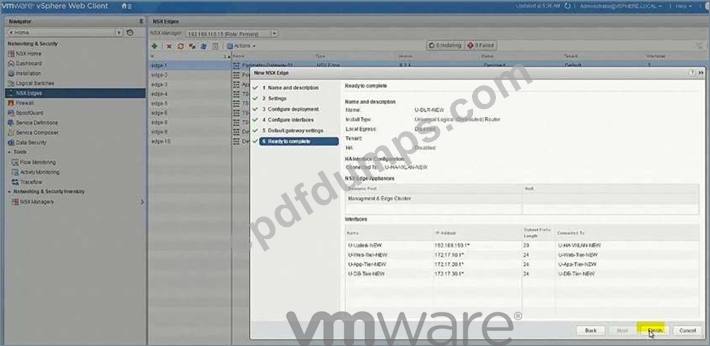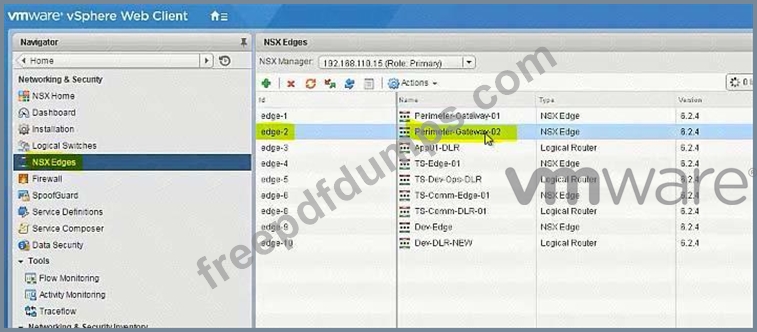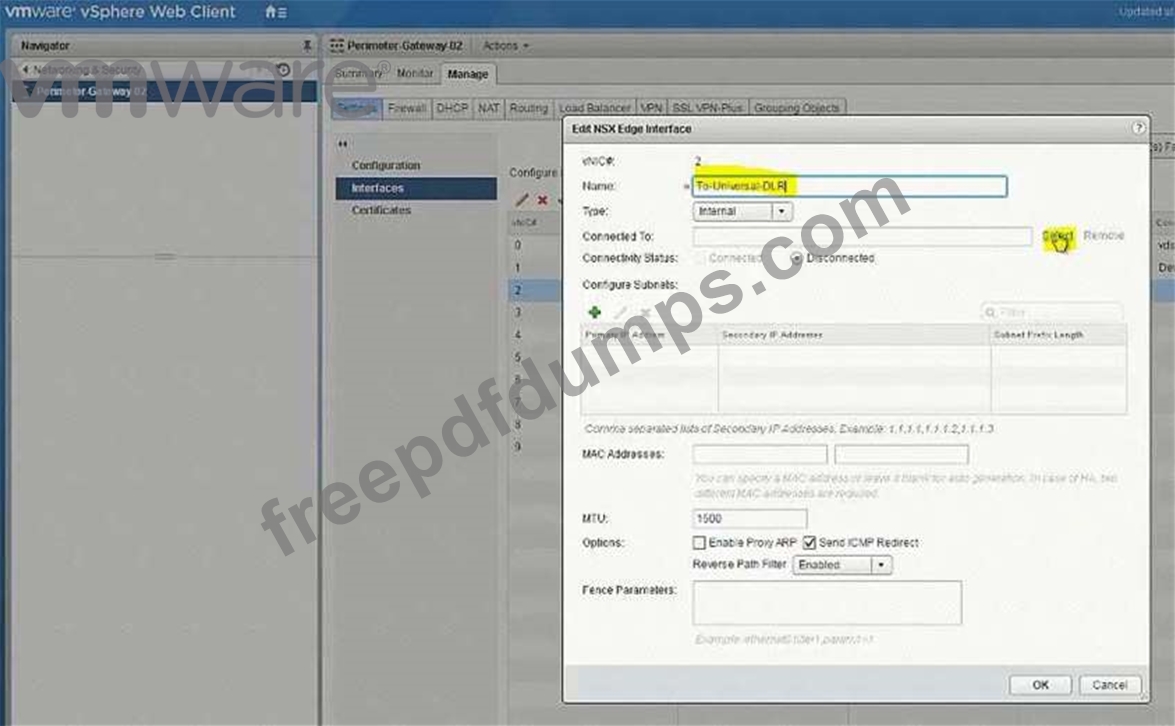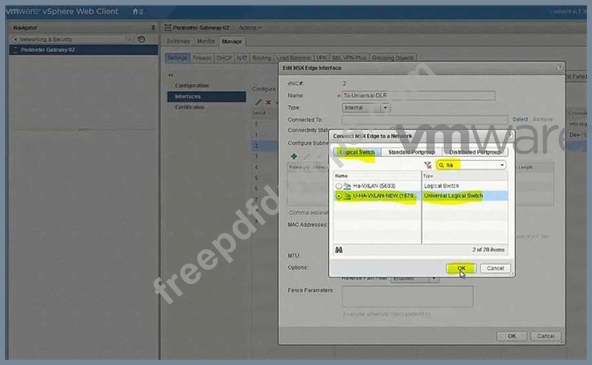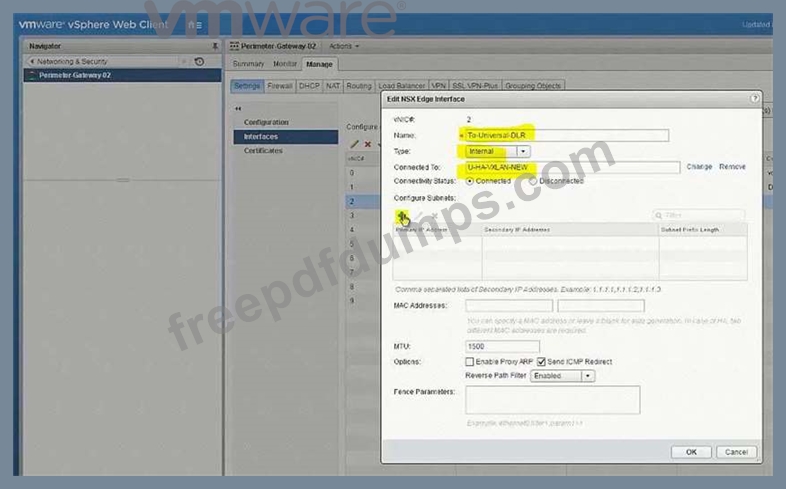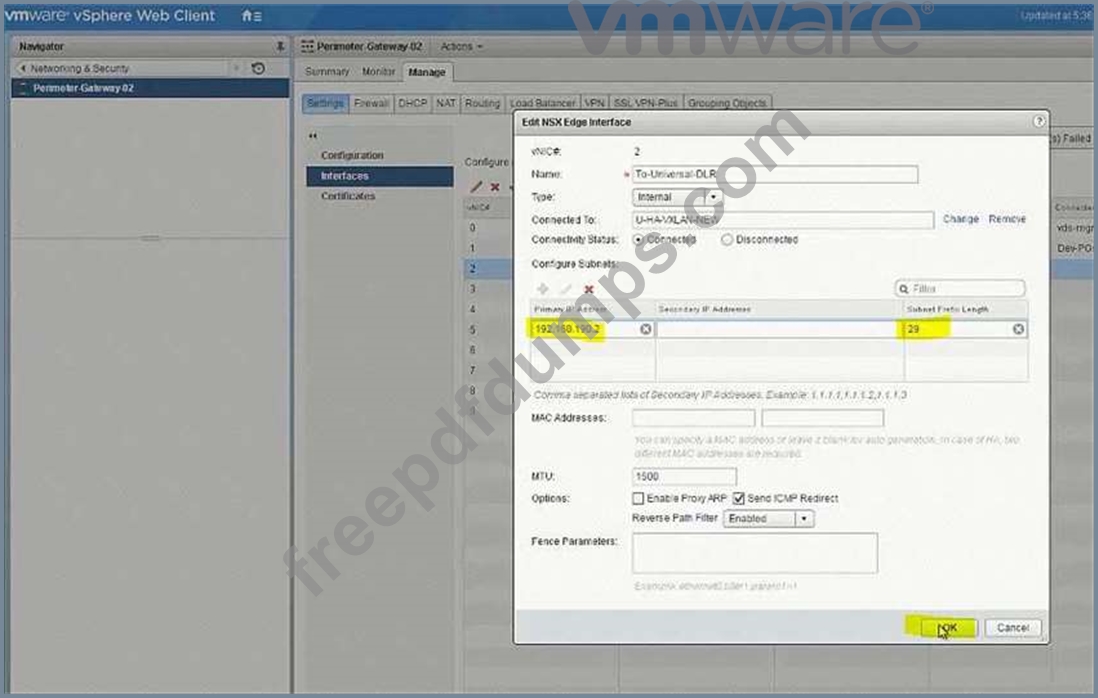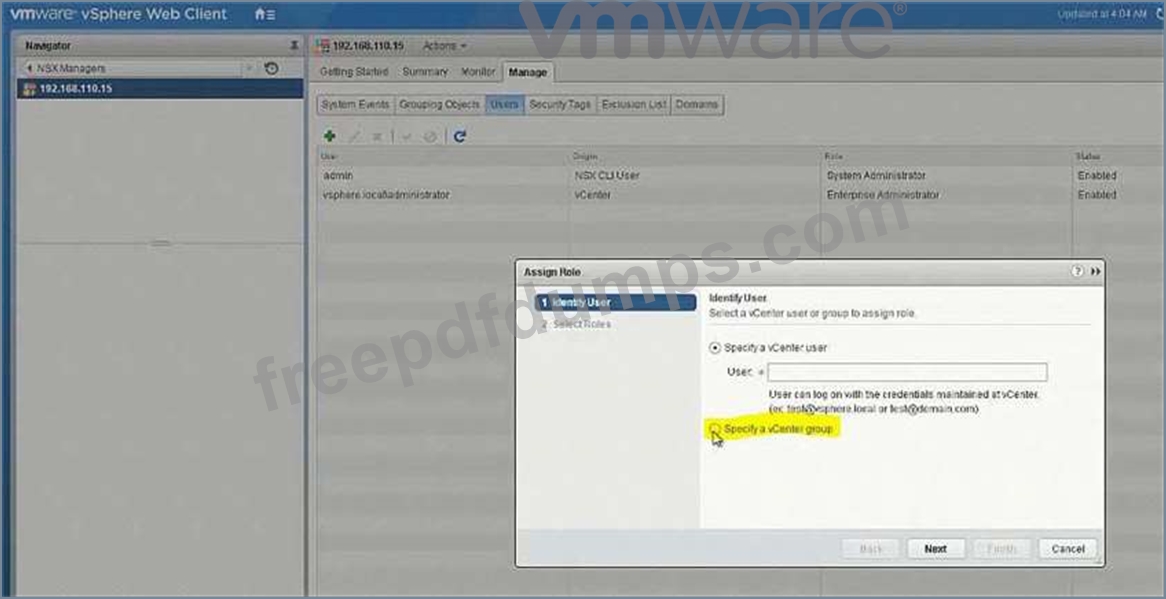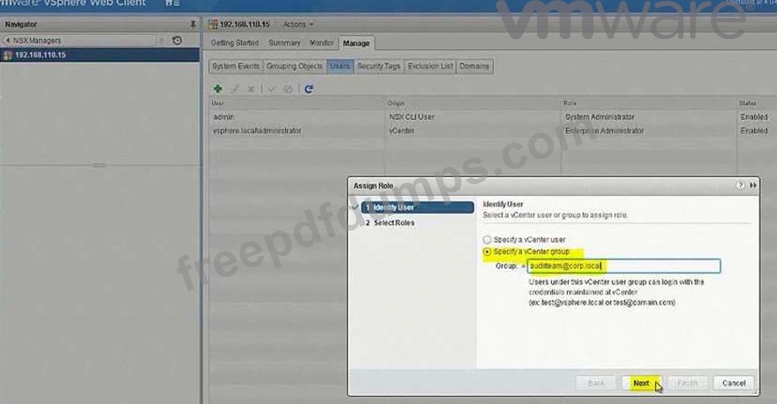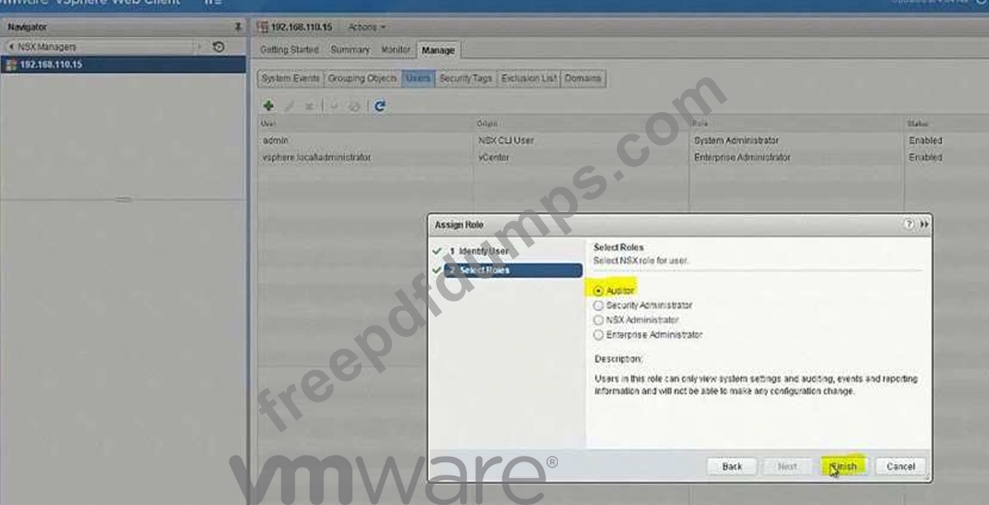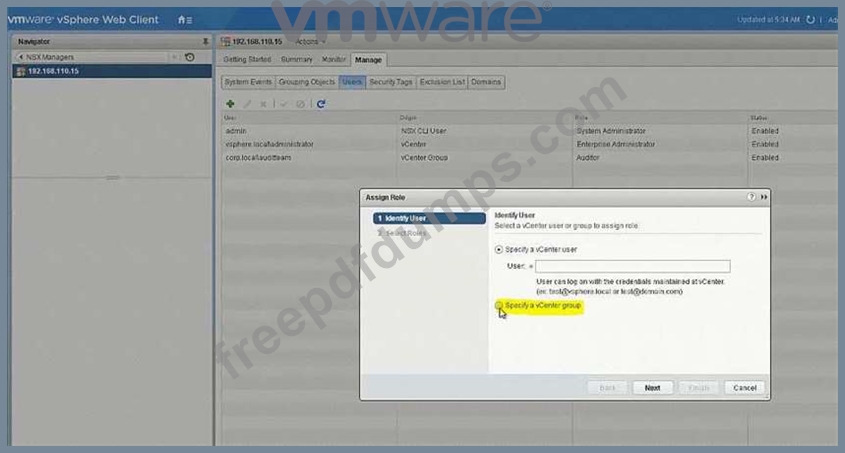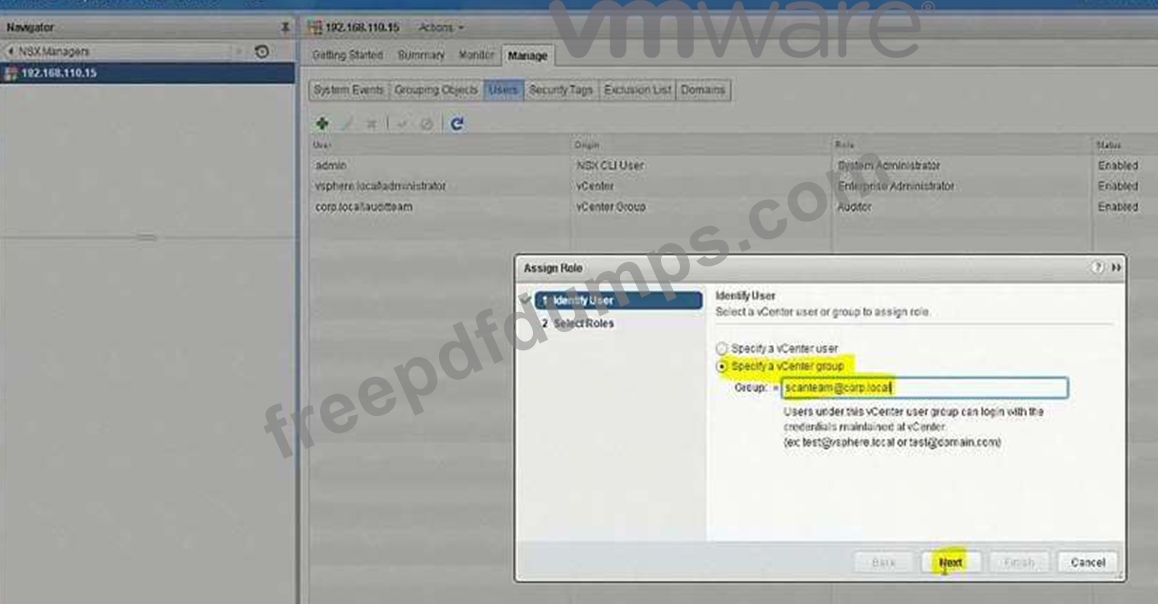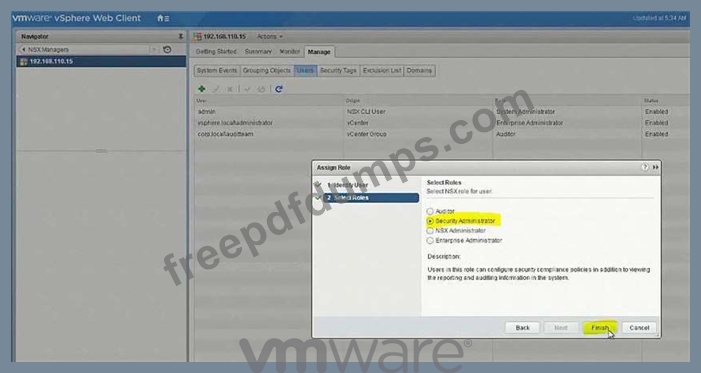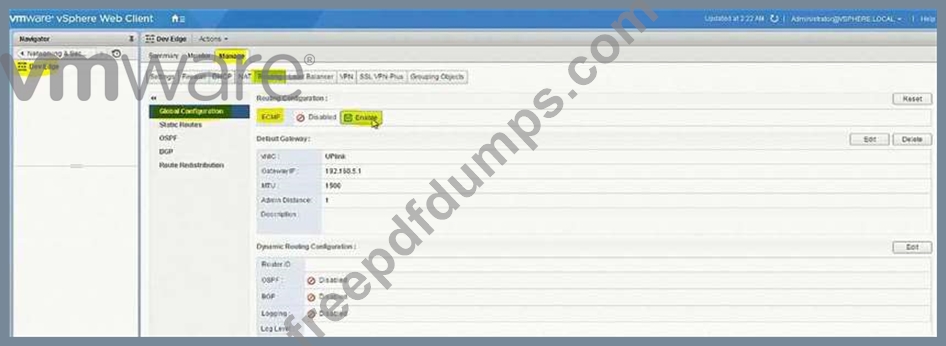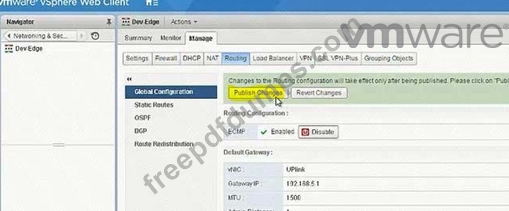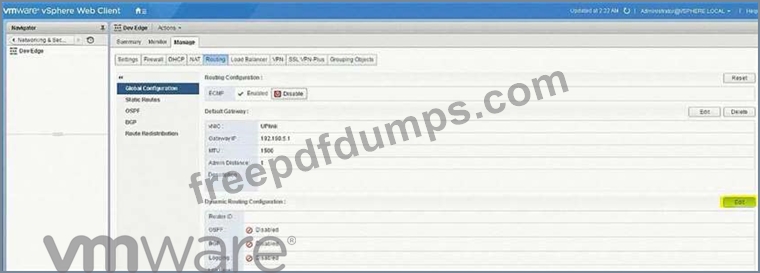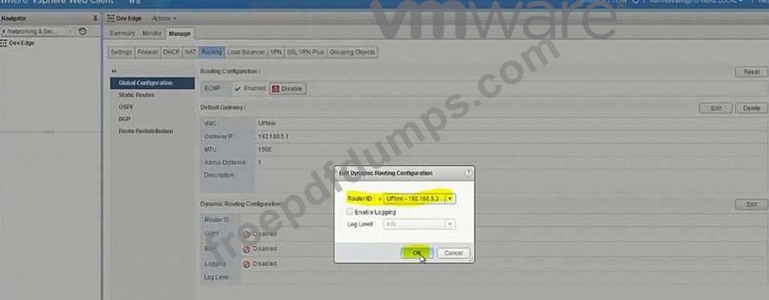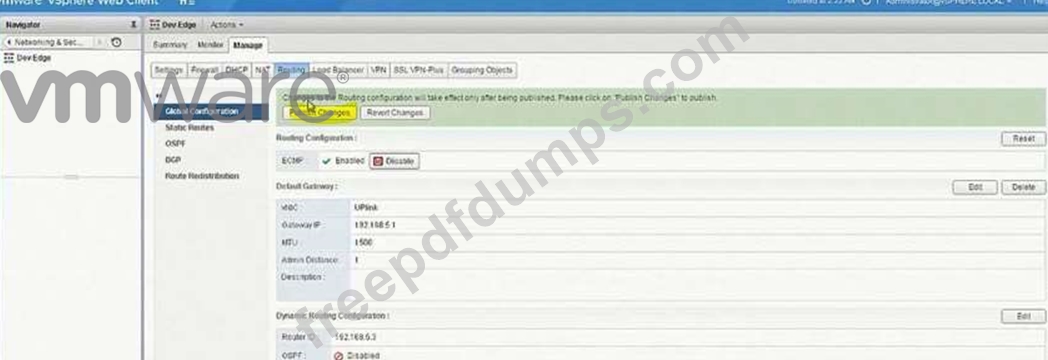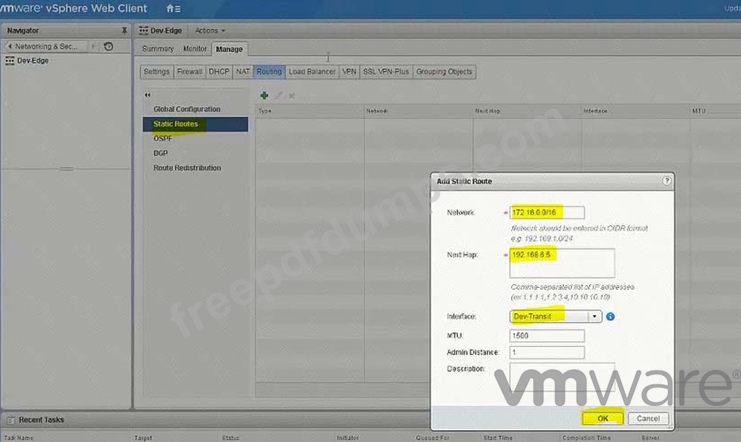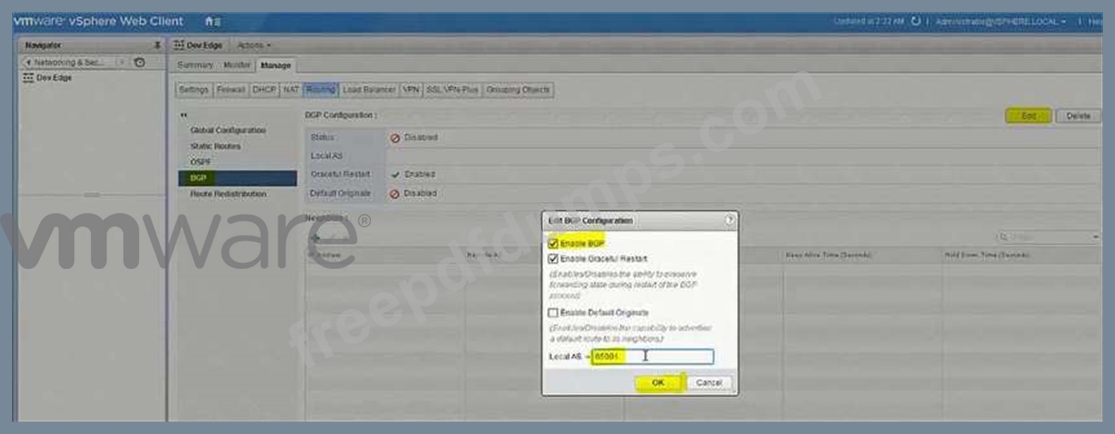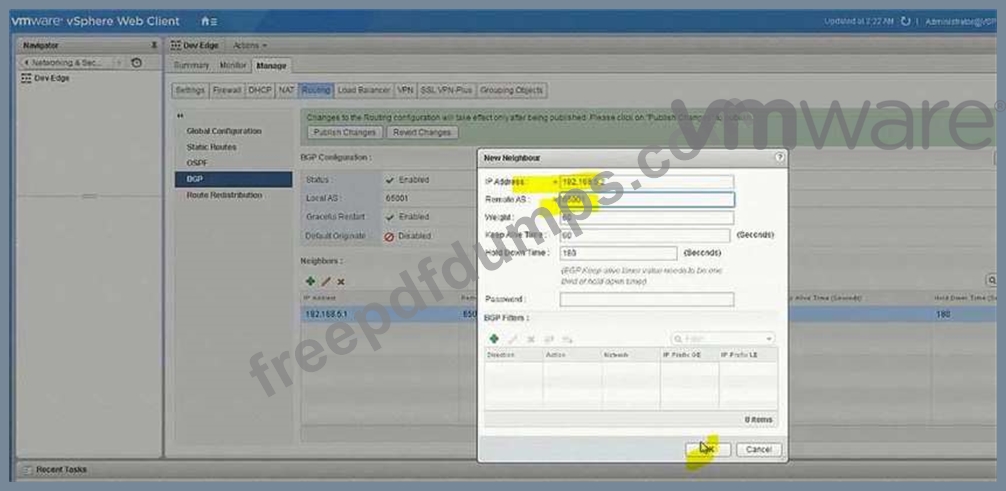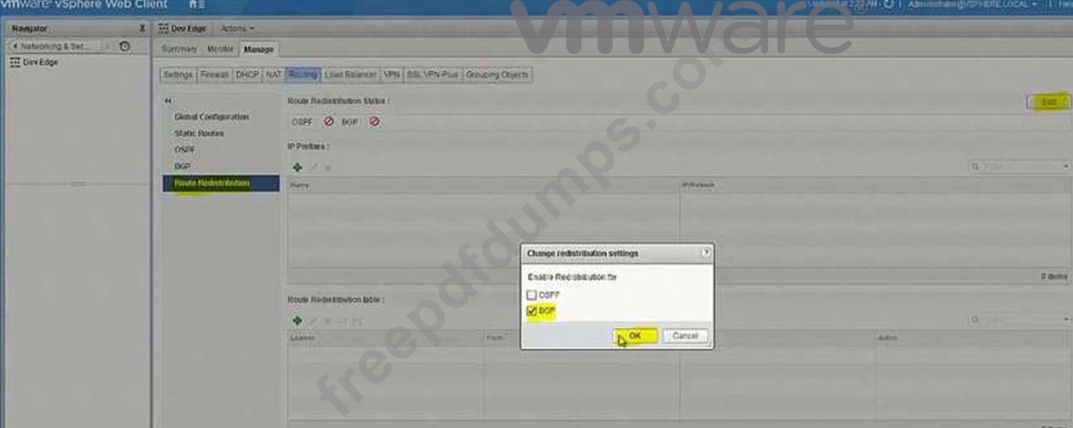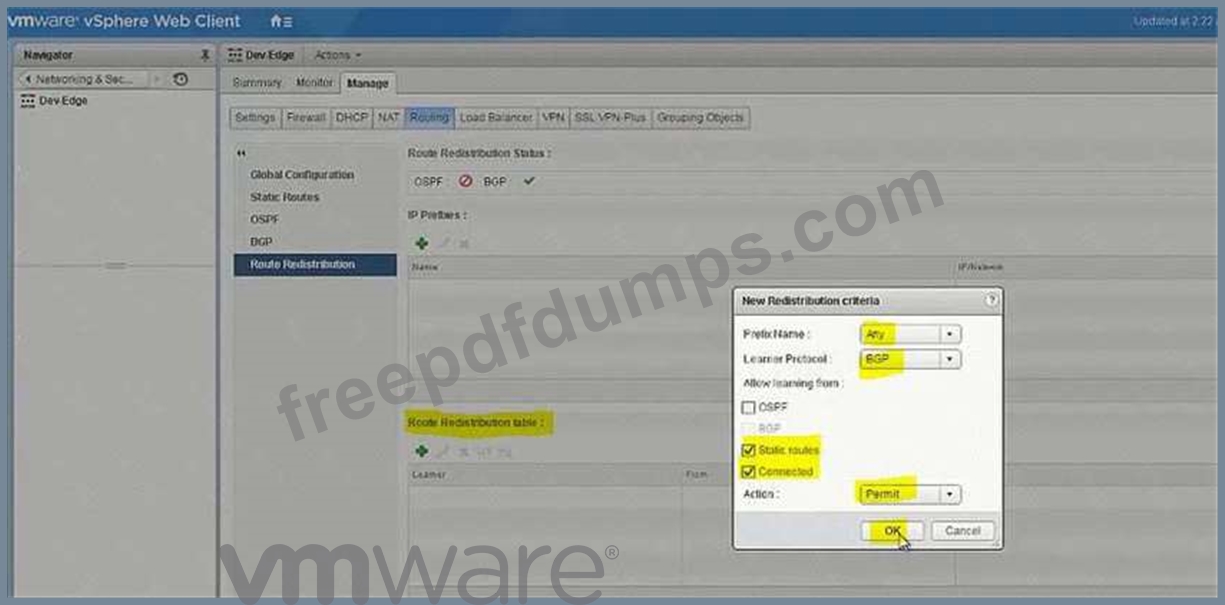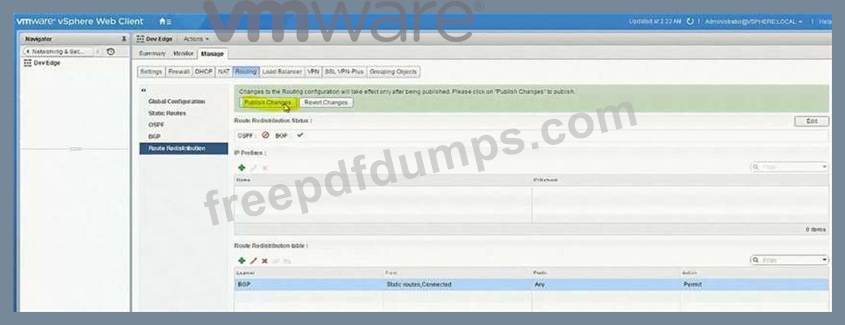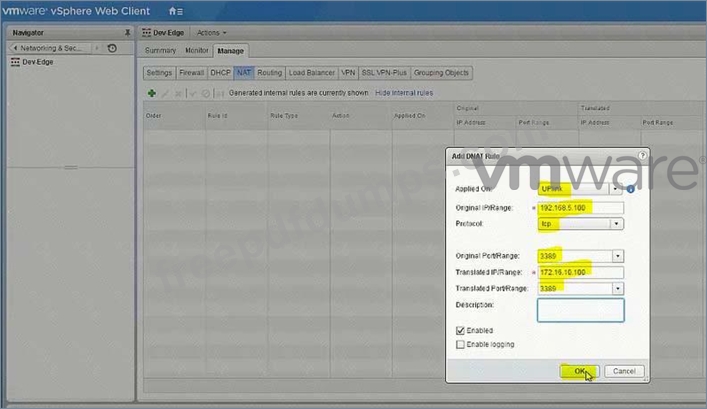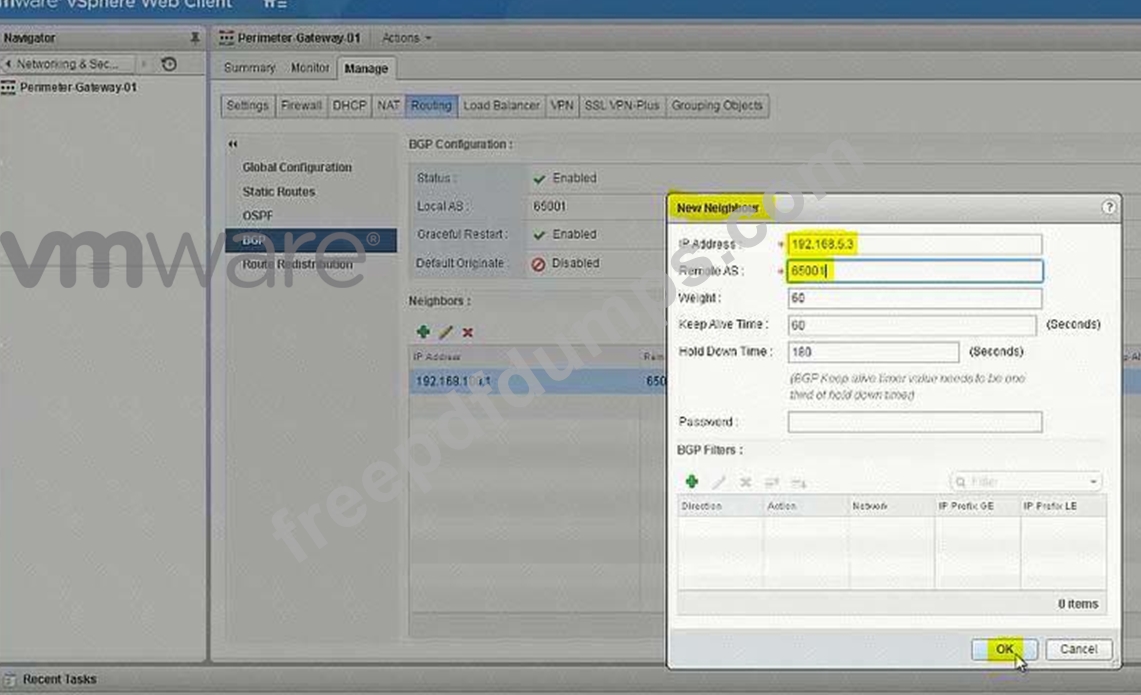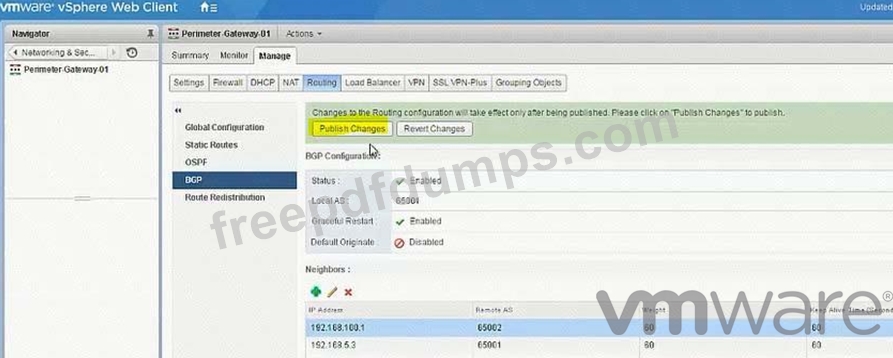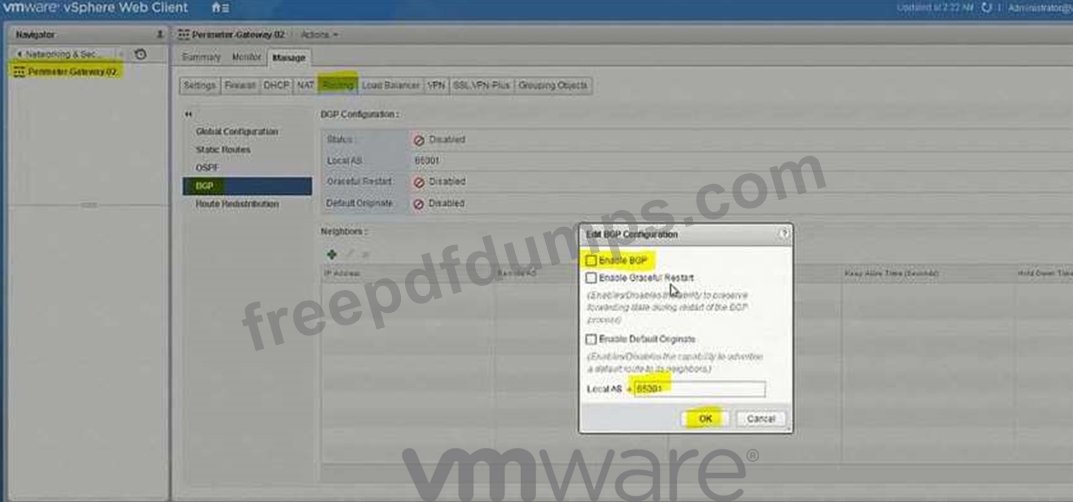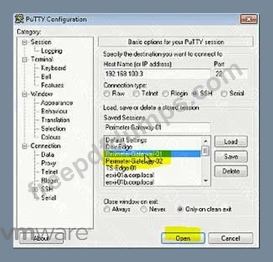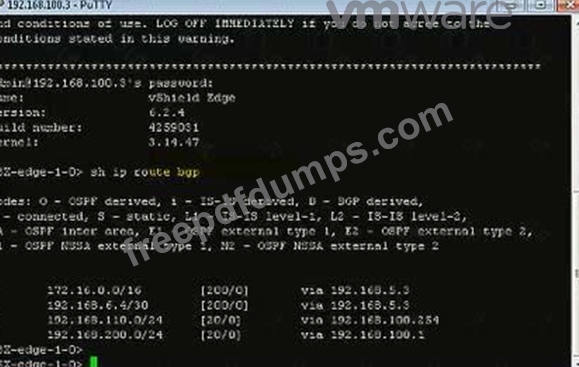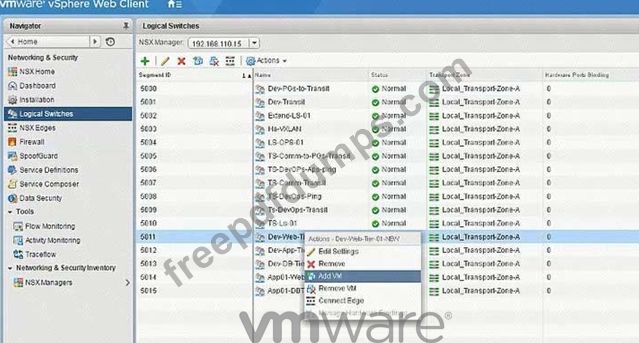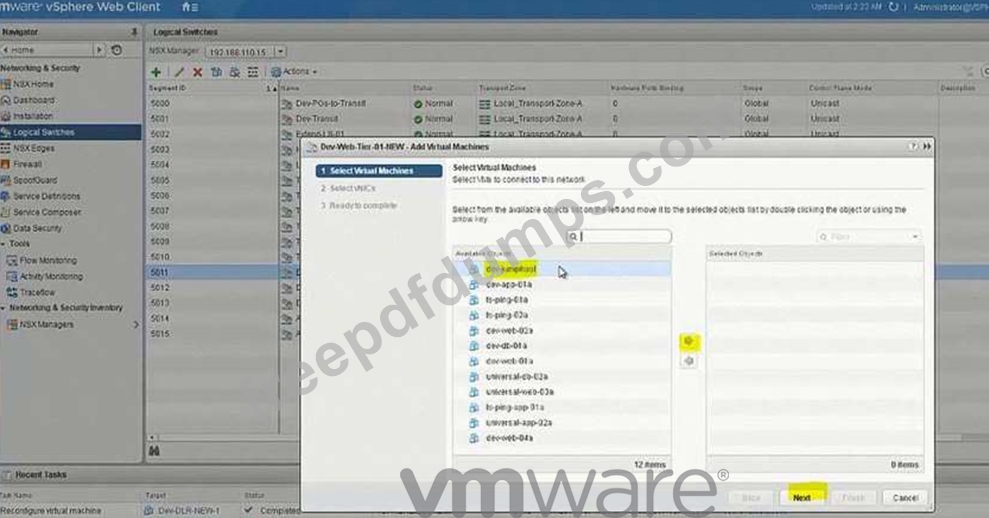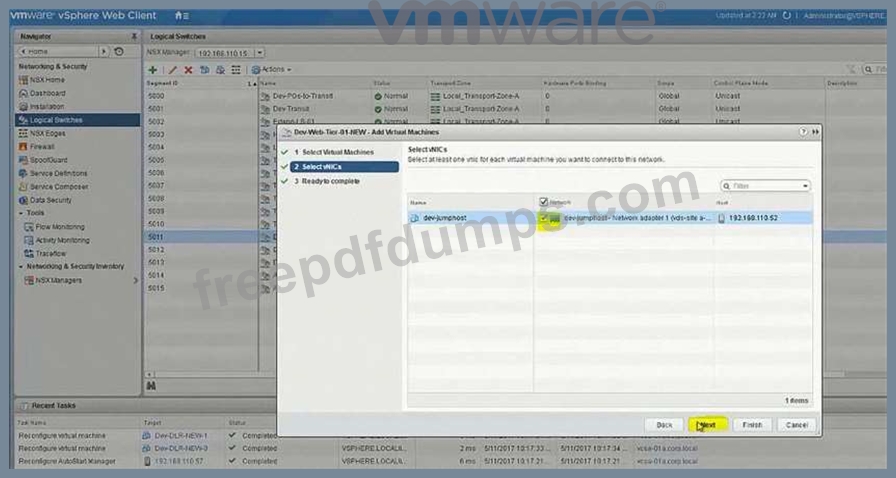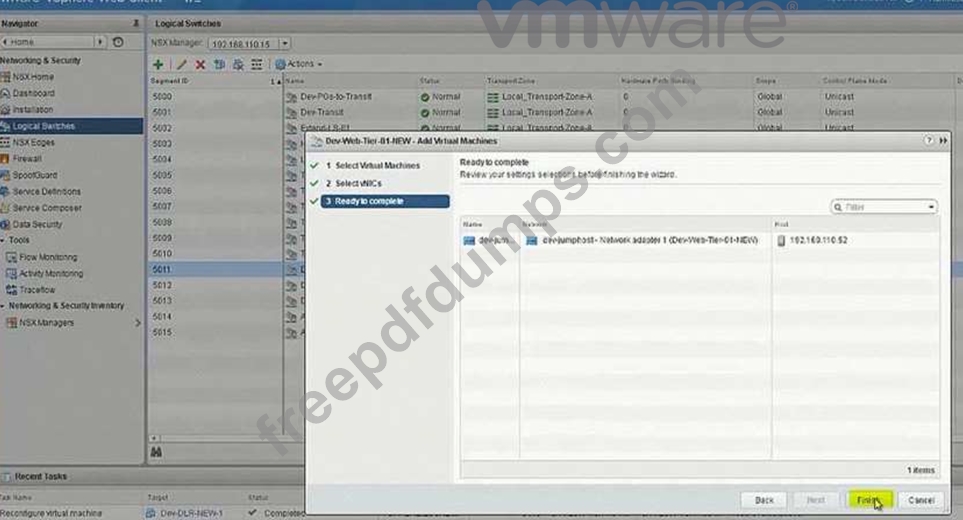3V0-643 Exam Question 1
In the previous scenario, vCenter vcsa-b.corp.local was configured for NSX. Now the hosts must be prepared for NSX and the initial VXLAN configuration should be completed.
Requirements:
vCenter: vcsa-01b.corp.local
Credentials: [email protected] / VMware1!
Cluster: Compute Cluster 1B
ESXi Hosts: esx-01b.corp.local, esx-02b.corp.local
VTEP Information:
VMKNic Teaming Policy: Fail Over
VLAN: 0
MTU: 1600
IP Pools for VTEP:
* Name: Compute_1B_VTEP_Pool-New
* Gateway: 192.168.230.1
* Prefix Length: 24
* Static IP Pool: 192.168.230.51 - 192.168.230.60
* Segment ID Pool: 6001-7000 - HOL 1903-01 Page 26-36
* VXLAN Span: Compute Cluster 1B - HOL 1903-01 Page 26-36
* Transport Zone: Local-Transport-Zone-B-New - HOL 1903-01 Page 26-36
* Host must be prepared for NSX
* Use provided information to complete the initial VXLAN configuration.
* The underlying physical network does not support multicast.
* Ensure that requirements are met:
* Create the IP Pool as given:
* Do the Host preparation.
* Create a Local Transport Zone as given. - HOL 1903-01 Page 26-36
* Create the segment ID as given. - HOL 1903-01 Page 26-36
HOL LAB for Practice:
http://docs.hol.vmware.com/hol-isim/HOL-2019/hol-1903-01-nsxinstall-p2.htm and LAB - HOL 1903-01 Page 26-36 See the explanation part for complete solution.
Requirements:
vCenter: vcsa-01b.corp.local
Credentials: [email protected] / VMware1!
Cluster: Compute Cluster 1B
ESXi Hosts: esx-01b.corp.local, esx-02b.corp.local
VTEP Information:
VMKNic Teaming Policy: Fail Over
VLAN: 0
MTU: 1600
IP Pools for VTEP:
* Name: Compute_1B_VTEP_Pool-New
* Gateway: 192.168.230.1
* Prefix Length: 24
* Static IP Pool: 192.168.230.51 - 192.168.230.60
* Segment ID Pool: 6001-7000 - HOL 1903-01 Page 26-36
* VXLAN Span: Compute Cluster 1B - HOL 1903-01 Page 26-36
* Transport Zone: Local-Transport-Zone-B-New - HOL 1903-01 Page 26-36
* Host must be prepared for NSX
* Use provided information to complete the initial VXLAN configuration.
* The underlying physical network does not support multicast.
* Ensure that requirements are met:
* Create the IP Pool as given:
* Do the Host preparation.
* Create a Local Transport Zone as given. - HOL 1903-01 Page 26-36
* Create the segment ID as given. - HOL 1903-01 Page 26-36
HOL LAB for Practice:
http://docs.hol.vmware.com/hol-isim/HOL-2019/hol-1903-01-nsxinstall-p2.htm and LAB - HOL 1903-01 Page 26-36 See the explanation part for complete solution.
3V0-643 Exam Question 2
Management has approved an expansion of the virtual infrastructure. You have been tasked to prepare Cross vCenter configuration with the second vCenter Server. Another administrator has provided a pre-configured vDS configuration file located on the Control Center Server. All identifiers must be maintained.
Requirements:
vCenterB server: vcsa-01b.corp.local
Credentials: [email protected] / VMware1!
vCenterB VAMI Credentials: root / VMware1!
Cluster: Computer Cluster 1B
ESXI Hosts: esx-01b.corp.local, esx-02.corp.local
Platform service controller: psc-01a.corp.local(192.168.110.9)
NSX Manager: nsmgr-01b.corp.local (192.168.210.15)
Credentials: admin / VMware1!
Time Zone: US/Pacific
*Configure nsmgr-01b.corp.local for vCenterB and psc-01a.corp.local
*Ensure nsxmgr-01b.corp.local uses the same NTP server as psc-01a.corp.local with a US/Pacific TimeZone.
*Import the new vDS configuration vds-site-b-Compute-New.zip
All identifiers must be maintained.
*Assign the remaining two used vmnics for the ESXi hosts to the newly imported vDS.
NOTE:
Do not migrate VMkernels from the standard switches on the hosts.
HOL LAB for Practice:
a http://docs.hol.vmware.com/hol-isim/HOL-2019/hol-1903-01-nsxinstall-p1.htm HOL-1903-01 Page 16 or you can directly Open a NSX manager in the lab and edit the existing settings bOpen PSC and NSX manager in HOL-1903-01 and look for NTP Server loand cation cExport existing vDS config and Import back the config for practice in HOL-1903-01 dNo Lab Module available See the explanation part for complete solution.
Requirements:
vCenterB server: vcsa-01b.corp.local
Credentials: [email protected] / VMware1!
vCenterB VAMI Credentials: root / VMware1!
Cluster: Computer Cluster 1B
ESXI Hosts: esx-01b.corp.local, esx-02.corp.local
Platform service controller: psc-01a.corp.local(192.168.110.9)
NSX Manager: nsmgr-01b.corp.local (192.168.210.15)
Credentials: admin / VMware1!
Time Zone: US/Pacific
*Configure nsmgr-01b.corp.local for vCenterB and psc-01a.corp.local
*Ensure nsxmgr-01b.corp.local uses the same NTP server as psc-01a.corp.local with a US/Pacific TimeZone.
*Import the new vDS configuration vds-site-b-Compute-New.zip
All identifiers must be maintained.
*Assign the remaining two used vmnics for the ESXi hosts to the newly imported vDS.
NOTE:
Do not migrate VMkernels from the standard switches on the hosts.
HOL LAB for Practice:
a http://docs.hol.vmware.com/hol-isim/HOL-2019/hol-1903-01-nsxinstall-p1.htm HOL-1903-01 Page 16 or you can directly Open a NSX manager in the lab and edit the existing settings bOpen PSC and NSX manager in HOL-1903-01 and look for NTP Server loand cation cExport existing vDS config and Import back the config for practice in HOL-1903-01 dNo Lab Module available See the explanation part for complete solution.
3V0-643 Exam Question 3
Build a multi-tier network capable of supporting application virtual machines deployed across multiple vCenter instances.
Requirements:
vCenter: vcsa-01a.corp.local
Credentials: [email protected] / VMware1!
Resource Pools: Management and Edge Cluster 1A
The underlying physical network does not support multicast.
All new items created must have a prefix of "U" followed by their function name and a suffix of "New".
i.e. U-App-Tier-NEW.
Create a LS for HA management interface calle U-HA-VXLAN=NEW but do not enable HA on any of the edge devices deployed.
Deploy logical switches using separate subnets for the three tier application shared by both NSX Manager instances.
Deploy the required east-west routing component used across multiple vCenter instances for the multi-tier network.
Utilize a default gateway up to the Perimeter-Gateway02 (tenant router) from the east/west router.
Utilize a static route from the tenant router to reach the three tiers of the application.
Subnets for the tiers:
172.7.10.0/24 for the Web Tier.
172.17.20.1/24 for the App Tier.
172.17.30.0/24 for the Database Teir.
Use the first available IP address for the router on each of the tiers.
Subnet for the Transit VXLAN uplink from the application tier routing to the tenant router.
192.168.190.0/29
Uplink IP address of the application tier should be the first available IP address.
Downlink from the tenant router will use the second available IP addresses.
The password for new edge device(s) must be VMware1!VMware1!
Add all virtual machines with a prefix "universal-" to their respective segments.
Ensure all LIFs are reachable from ControlCenter.
HOL LAB for Practice:
See the explanation part for complete solution.
Requirements:
vCenter: vcsa-01a.corp.local
Credentials: [email protected] / VMware1!
Resource Pools: Management and Edge Cluster 1A
The underlying physical network does not support multicast.
All new items created must have a prefix of "U" followed by their function name and a suffix of "New".
i.e. U-App-Tier-NEW.
Create a LS for HA management interface calle U-HA-VXLAN=NEW but do not enable HA on any of the edge devices deployed.
Deploy logical switches using separate subnets for the three tier application shared by both NSX Manager instances.
Deploy the required east-west routing component used across multiple vCenter instances for the multi-tier network.
Utilize a default gateway up to the Perimeter-Gateway02 (tenant router) from the east/west router.
Utilize a static route from the tenant router to reach the three tiers of the application.
Subnets for the tiers:
172.7.10.0/24 for the Web Tier.
172.17.20.1/24 for the App Tier.
172.17.30.0/24 for the Database Teir.
Use the first available IP address for the router on each of the tiers.
Subnet for the Transit VXLAN uplink from the application tier routing to the tenant router.
192.168.190.0/29
Uplink IP address of the application tier should be the first available IP address.
Downlink from the tenant router will use the second available IP addresses.
The password for new edge device(s) must be VMware1!VMware1!
Add all virtual machines with a prefix "universal-" to their respective segments.
Ensure all LIFs are reachable from ControlCenter.
HOL LAB for Practice:
See the explanation part for complete solution.
3V0-643 Exam Question 4
The security team has submitted two requests to change or limit access in NSX for Site A's vCenter groups.
Requirements:
NSX Manager: nsxmgr-01a.corp.local
vCenter: vcsa-01a.corp.local
Credentials: [email protected] / VMware1!
Grant all members of vCenter group AuditTeam the minimal access necessary to view NSX Data Security policy configurations for all objects in Site A.
Grant all members of vCenter group ScanTeam the minimal access necessary to enable them to start and stop data security scans in Site A.
Ensure that the principles of least privilege are adhered to.
NOTE:
The Active Directory groups associated with the vCenter groups has already been preconfigured.
HOL LAB for Practice:
See the explanation part for complete solution.
Requirements:
NSX Manager: nsxmgr-01a.corp.local
vCenter: vcsa-01a.corp.local
Credentials: [email protected] / VMware1!
Grant all members of vCenter group AuditTeam the minimal access necessary to view NSX Data Security policy configurations for all objects in Site A.
Grant all members of vCenter group ScanTeam the minimal access necessary to enable them to start and stop data security scans in Site A.
Ensure that the principles of least privilege are adhered to.
NOTE:
The Active Directory groups associated with the vCenter groups has already been preconfigured.
HOL LAB for Practice:
See the explanation part for complete solution.
3V0-643 Exam Question 5
Complete the configuration of Dev-Edge to allow north-south routing connectivity for the new Dev-segment.
Workloads will have overlapping IP addressing with production workloads. The developers will RDP into a jump host server (Dev-Jumphost) on the Dev-Web segment. An RDP shortcut named To Dev-JumpHost.rdp has been created on the ControlCenter Desktop.
The following has been preconfigured on Dev-Edge:
The uplink interface on the Dev-Edge has been pre-configured to communicate the upstream Gateways and attached to Dev-to-PGs-Transit.
Dev-DLR-NEW and Dev-Edge interfaces have been preconfigured to communicate with each other.
ECMP has been disabled.
Requirements:
vCenter: vcsa-01a.corp.local
Credentials: [email protected] / VMware1!
Dev-Jumphost information:
Credentials: administrator / VMware1!
Internal IP of Dev-Jumphost: 172.16.10.100
External IP of Dev-Jumphost: 192.168.5.100
Connection Information:
Dev-Edge-Uplink IP: 192.168.5.3/24
Dev-Edge-Internal IP : 192.168.6.6/30
Preimeter-Gateway-01-Internal IP: 192.168.5.1/24
Preimeter-Gateway-02-Internal IP: 192.168.5.2/24
Logical switch: Dev-to-PGs-Transit
ECMP: Enabled.
BGP AS: 65001
Credentials for all Edge Devices: admin / VMware1!VMware1!
The networking team requires BGP as a routing protocol with an AS of 65001 for North-bound access for the Dev-environment.
Use the fewest number of static routes and utilize network prefixes to ensure accessibility to the Dev-Web-Tier-01-NEW within the Dev-environment.
Ensure Dev-Jumphost is on Dev-Web-Tier-01-NEW.
Ensure the ability to RDP into the Dev-Jumphost server from the production network (ControlCenter).
HOL LAB for Practice:
module, it will be use full for other question like 20 and 22
See the explanation part for complete solution.
Workloads will have overlapping IP addressing with production workloads. The developers will RDP into a jump host server (Dev-Jumphost) on the Dev-Web segment. An RDP shortcut named To Dev-JumpHost.rdp has been created on the ControlCenter Desktop.
The following has been preconfigured on Dev-Edge:
The uplink interface on the Dev-Edge has been pre-configured to communicate the upstream Gateways and attached to Dev-to-PGs-Transit.
Dev-DLR-NEW and Dev-Edge interfaces have been preconfigured to communicate with each other.
ECMP has been disabled.
Requirements:
vCenter: vcsa-01a.corp.local
Credentials: [email protected] / VMware1!
Dev-Jumphost information:
Credentials: administrator / VMware1!
Internal IP of Dev-Jumphost: 172.16.10.100
External IP of Dev-Jumphost: 192.168.5.100
Connection Information:
Dev-Edge-Uplink IP: 192.168.5.3/24
Dev-Edge-Internal IP : 192.168.6.6/30
Preimeter-Gateway-01-Internal IP: 192.168.5.1/24
Preimeter-Gateway-02-Internal IP: 192.168.5.2/24
Logical switch: Dev-to-PGs-Transit
ECMP: Enabled.
BGP AS: 65001
Credentials for all Edge Devices: admin / VMware1!VMware1!
The networking team requires BGP as a routing protocol with an AS of 65001 for North-bound access for the Dev-environment.
Use the fewest number of static routes and utilize network prefixes to ensure accessibility to the Dev-Web-Tier-01-NEW within the Dev-environment.
Ensure Dev-Jumphost is on Dev-Web-Tier-01-NEW.
Ensure the ability to RDP into the Dev-Jumphost server from the production network (ControlCenter).
HOL LAB for Practice:
module, it will be use full for other question like 20 and 22
See the explanation part for complete solution.


